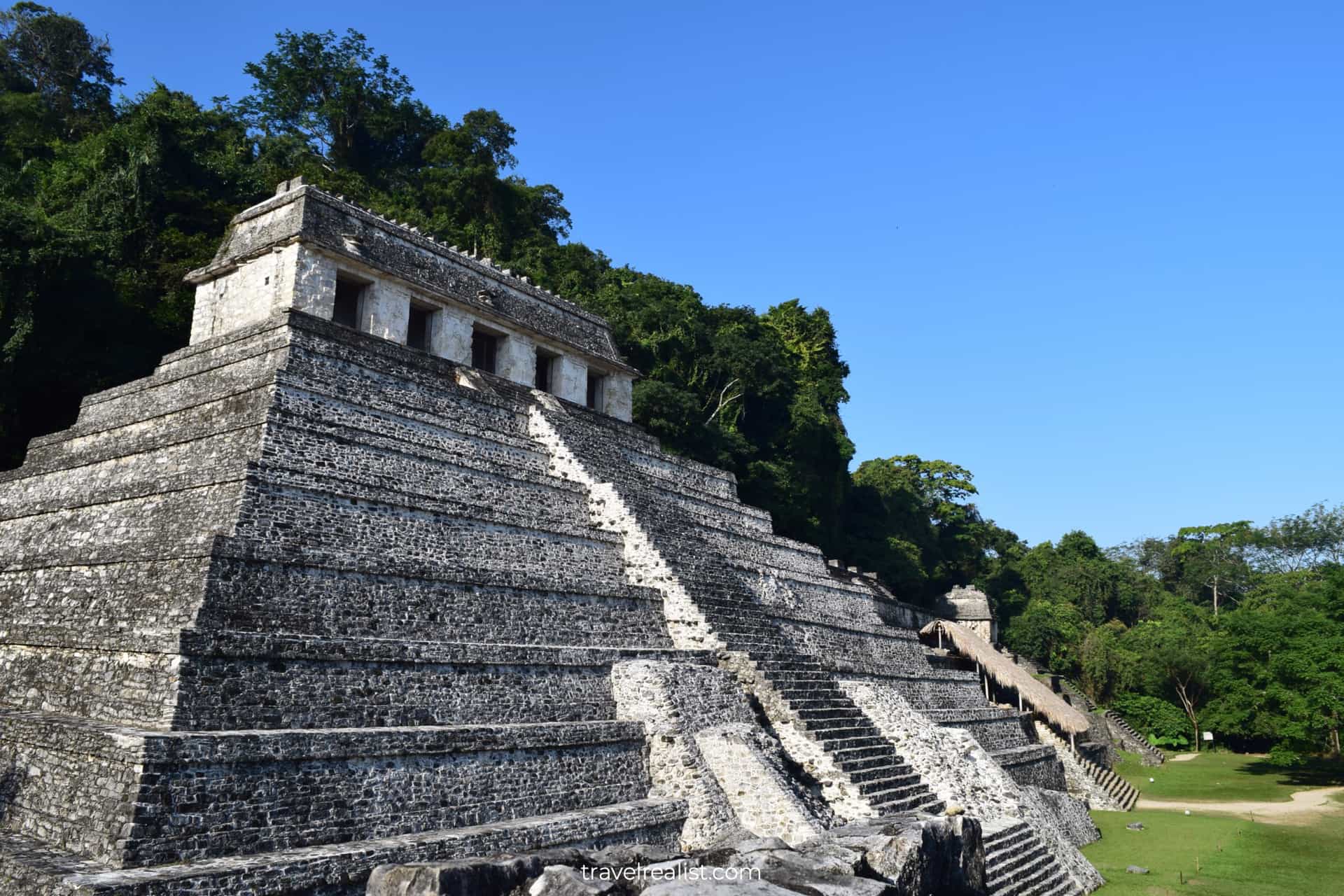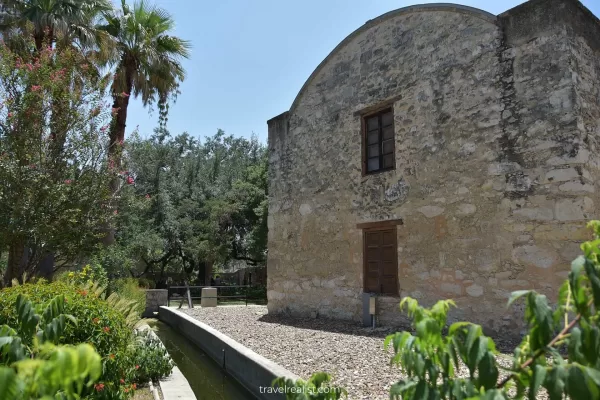Yellowstone: Geysers & Hot Springs in Single Park
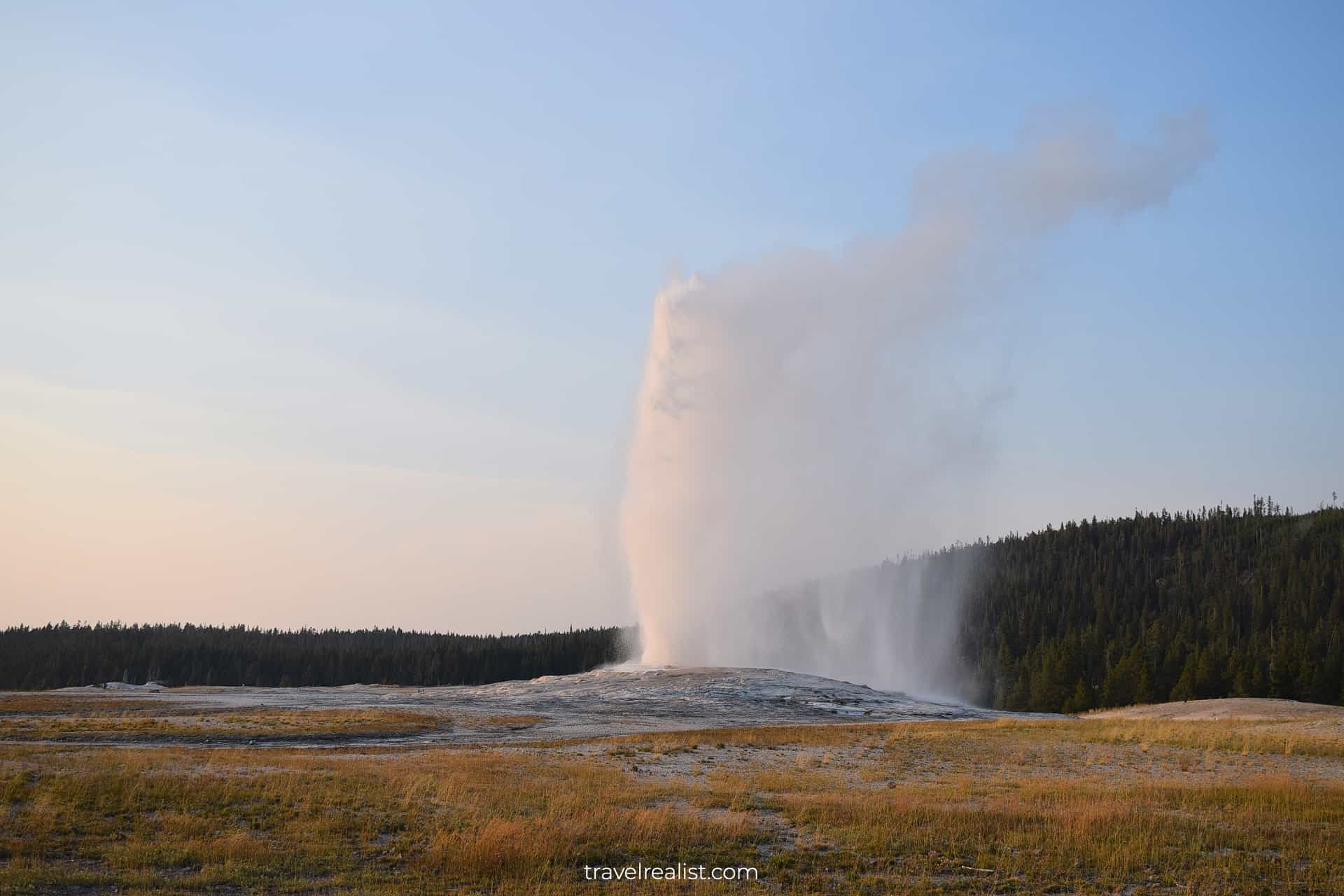
Yellowstone National Park Guide
Use our realist Yellowstone Guide to plan your next adventure in this national park. Yellowstone National Park is a vast park best known for geysers, hot springs, falls, lakes, terraces, and wildlife.
- Sights & Places of Interest
- Getting to Yellowstone
- Where to Stay
- Entrance Requirements & Passes
- Takeaways: Yellowstone
This post includes affiliate links that will earn us commission if you make a purchase via these links.
Sights & Places of Interest
Yellowstone National Park was the first national park in the United States. It has been protected since 1872. National parks were a novel concept at the time. Therefore, Yellowstone is also the first national park in the world.
Yellowstone has countless places of interest. Its sights range from geyser and hot springs basins to waterfalls and lakes. Such variety allows you to customize your visit by focusing on different park areas. Our Yellowstone Guide follows the path of our park visit.
Old Faithful Geyser
We started our Yellowstone exploration by visiting Old Faithful Geyser. Without any doubt, it is one of the park’s crown jewels.
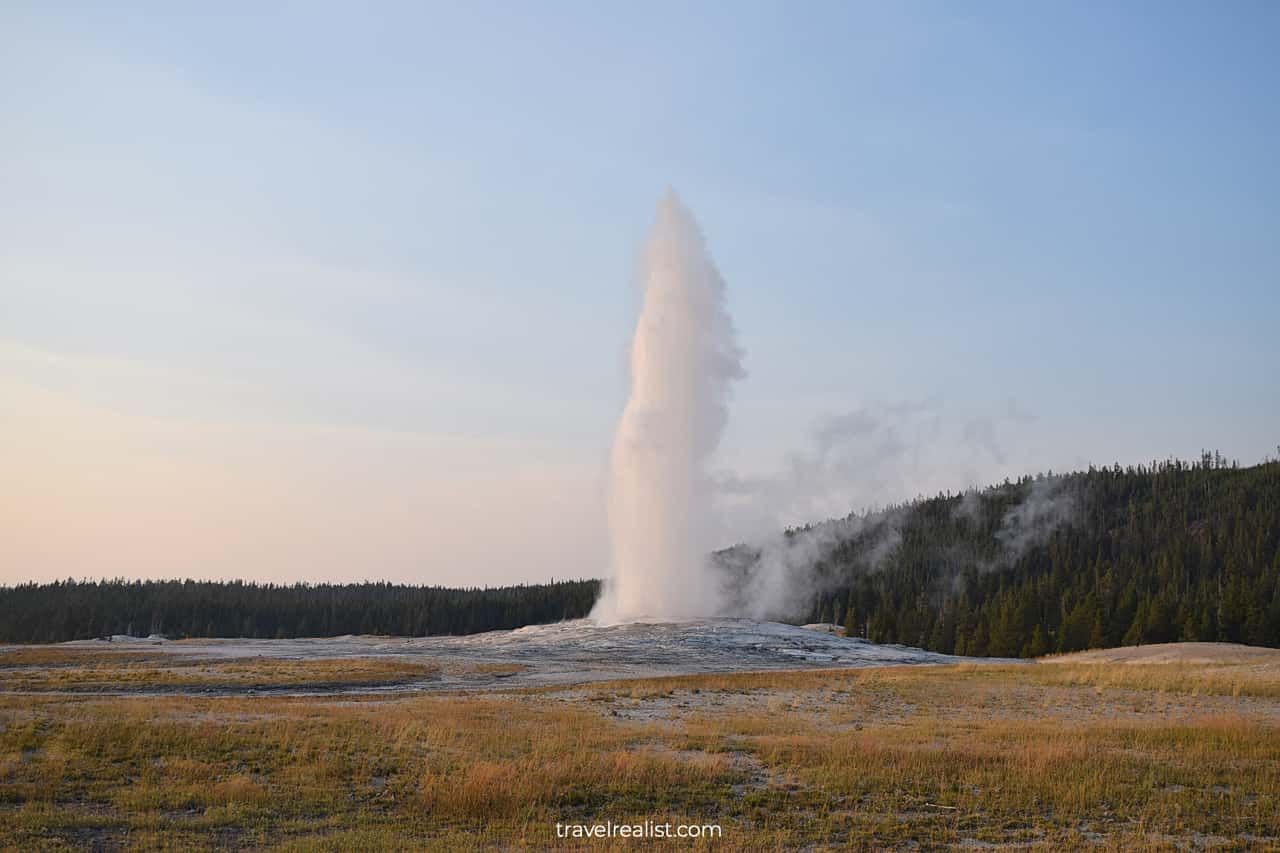
Old Faithful Geyser erupts regularly, every 40 to 60 minutes. Its eruption height ranges from 100 ft to 185 ft (30 m to 56 m). It is a lot higher than the original Geysir we visited in Iceland.
It is difficult to time arrival time with an eruption. You will most likely have to wait at an observation area next to the Geyser. If the observation deck is not crowded, you likely just missed an eruption. If most bench seats are taken, your wait might be short.
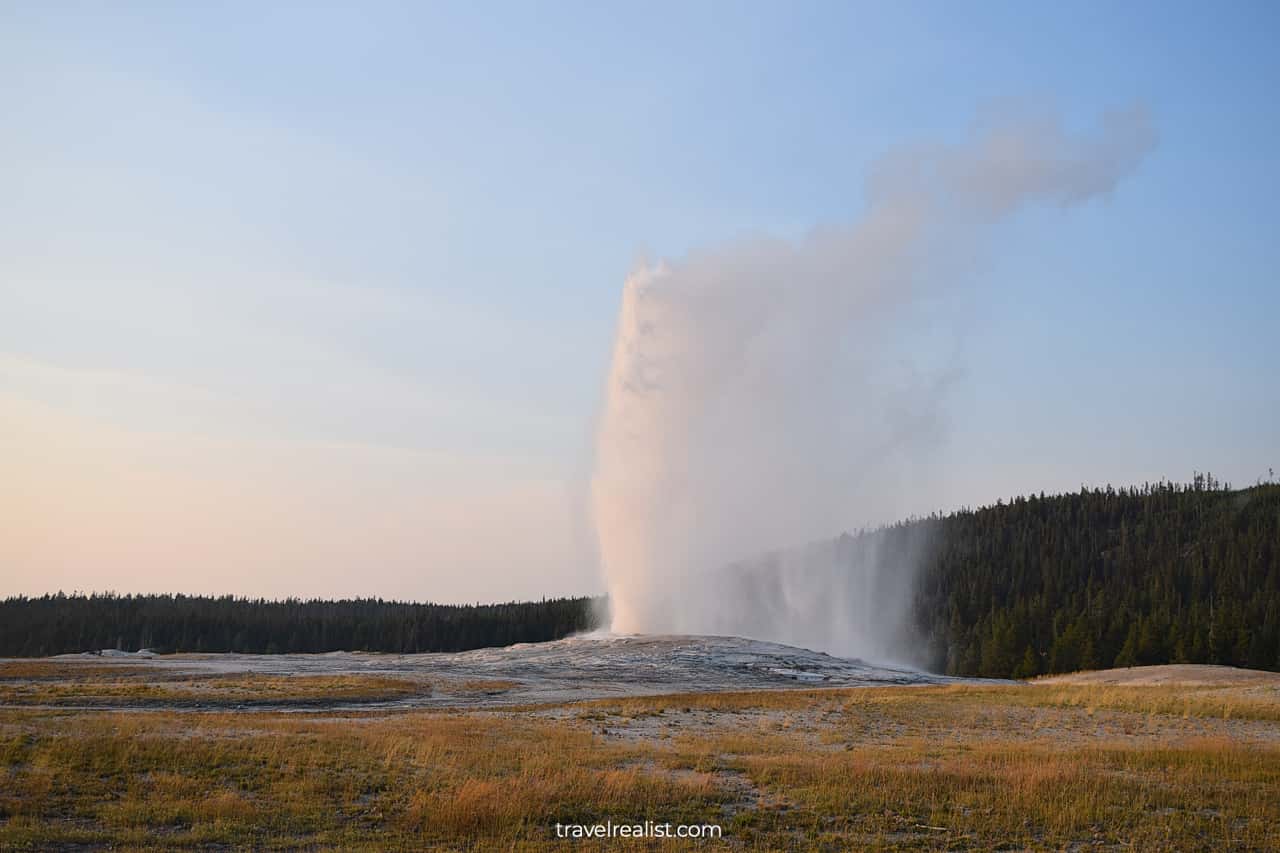
The Old Faithful Geyser’s eruption is an astonishing display of geological forces. It is absolutely worth a wait. Once we watched the eruption up close, we proceed to explore other nearby sights.
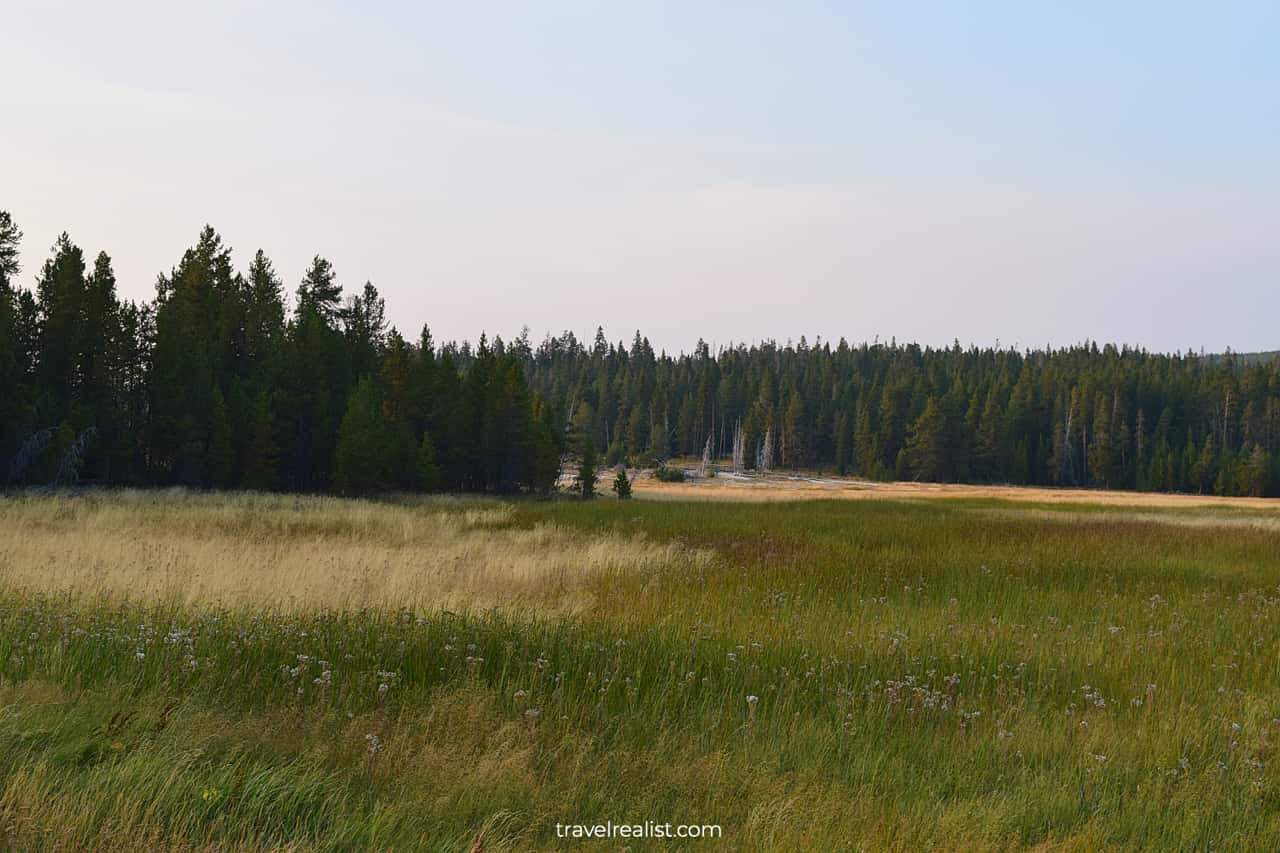
Castle Geyser
The Old Faithful area features several other geysers. The Castle Geyser was releasing steam when we arrived.
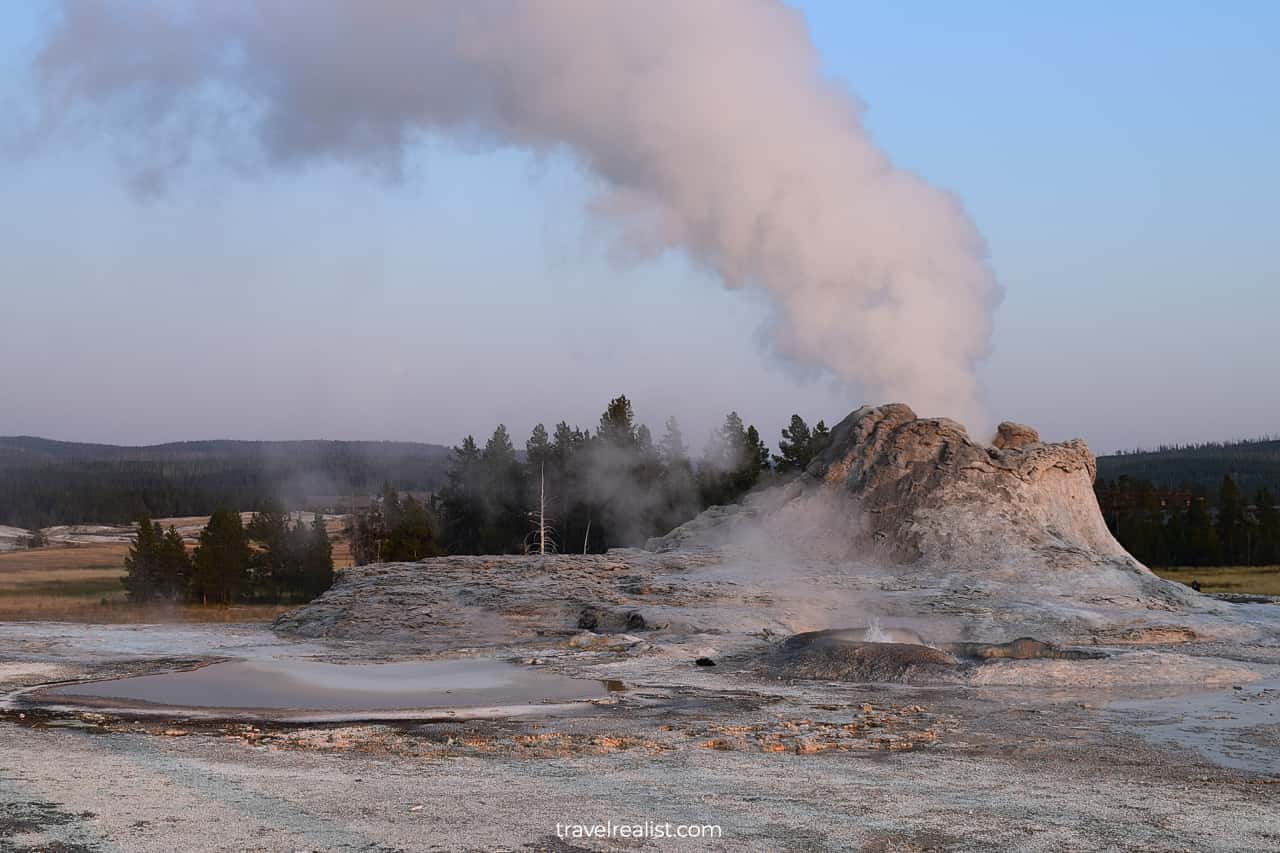
This geyser continued emitting gases during the entire time we were exploring this park area.
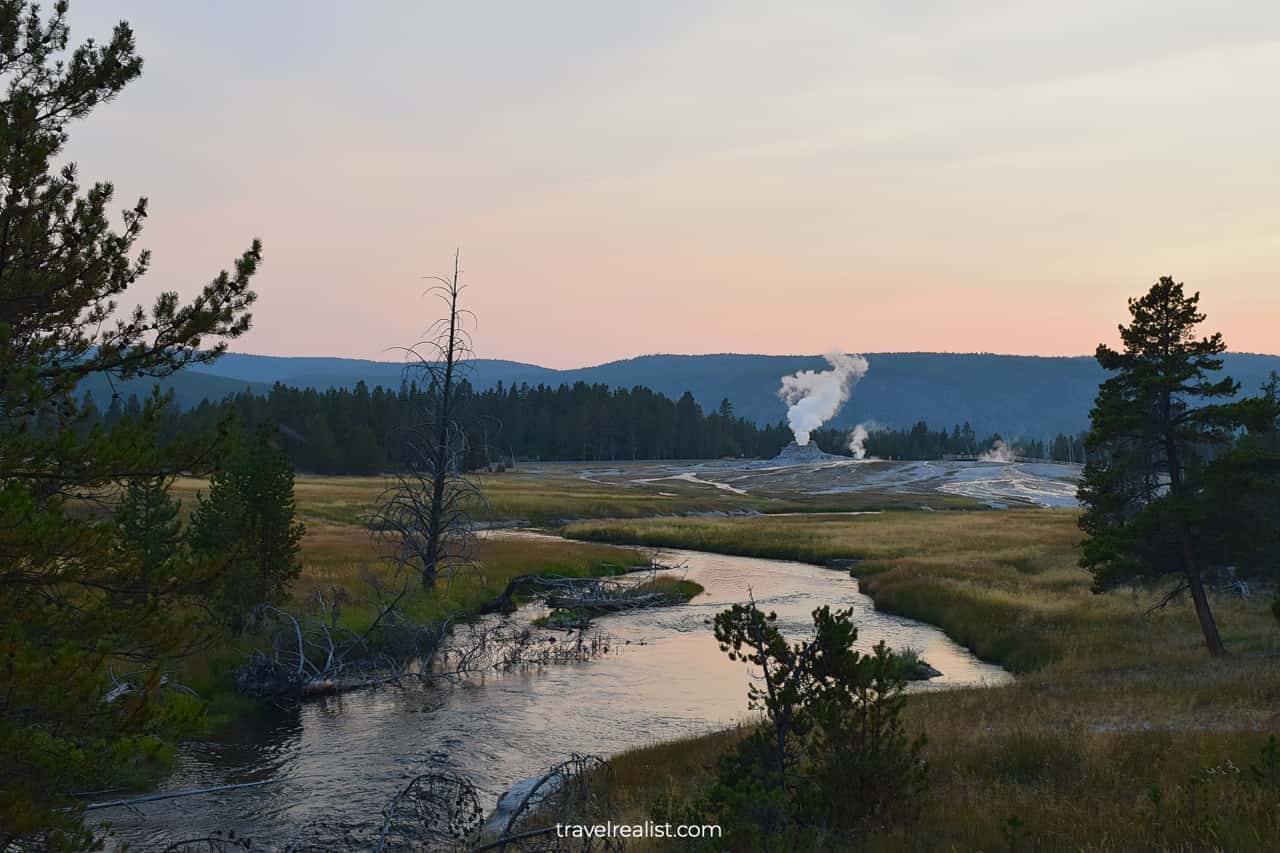
Geysir Hill
The Geyser Hill‘s formations followed suit. Continuous steam release made the sunset particularly scenic. These calm views marked the end of our first day in the park.
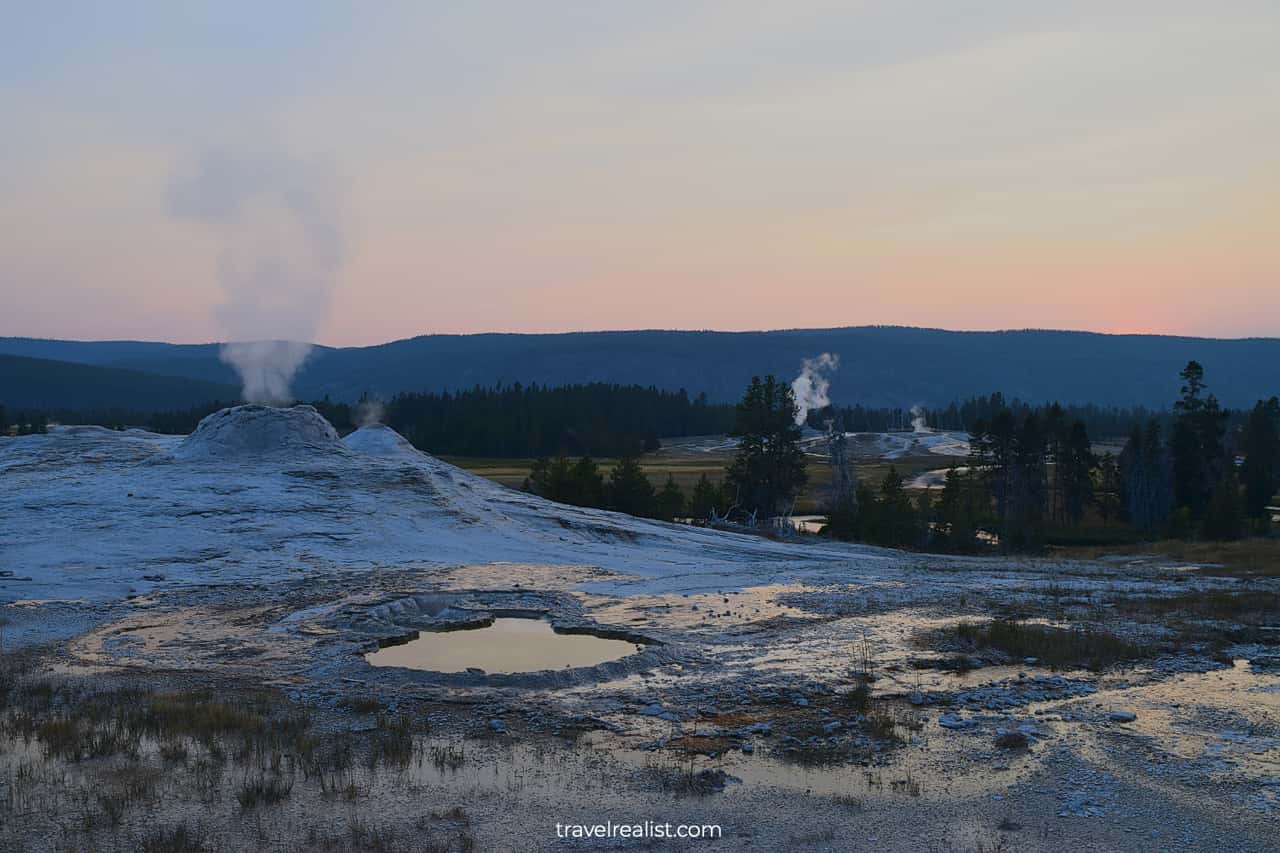
Isa Lake
We drove back to the park the next morning. The Isa Lake was our first stop. This lake is located on the Continental Divide. Water lilies and reflections made a great combination.
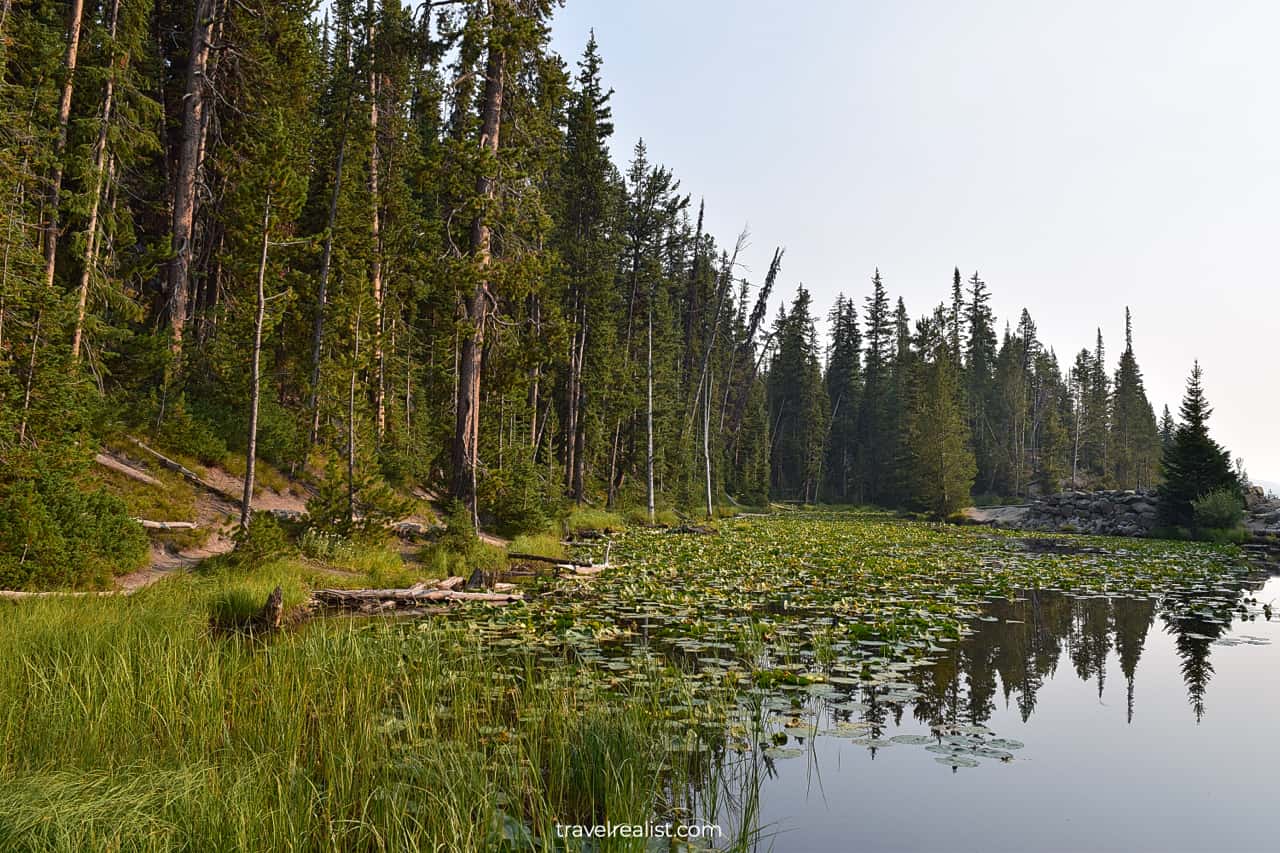
Black Sand Basin
We drove past the Old Faithful Geyser area since we visited it the day before. The nearby Black Sand Basin was the next item on our itinerary.
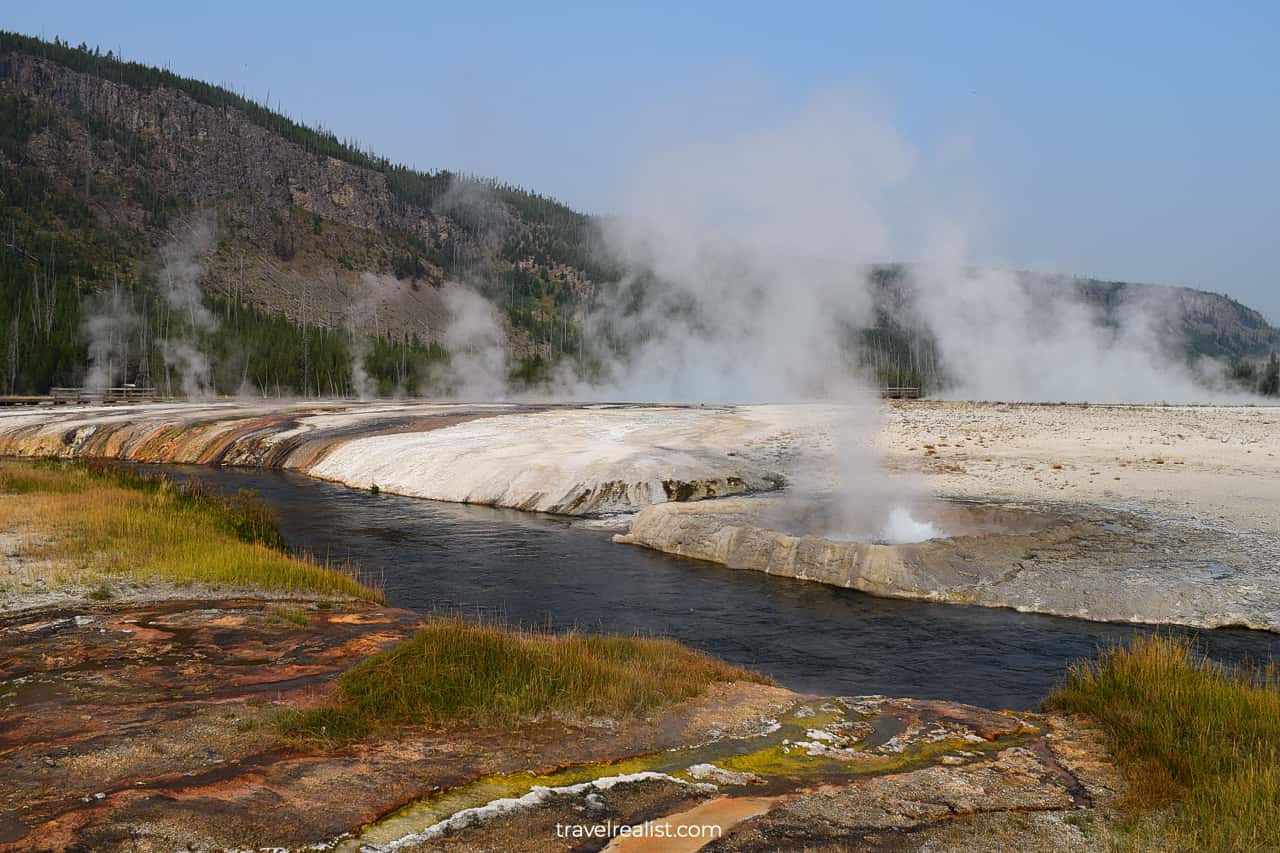
Spouter Geyser
This basin features smaller geysers, springs, and pools compared to Old Faithful. But it does not make these formations any less breathtaking. You could observe Spouter Geyser‘s eruptions that happen from time to time.
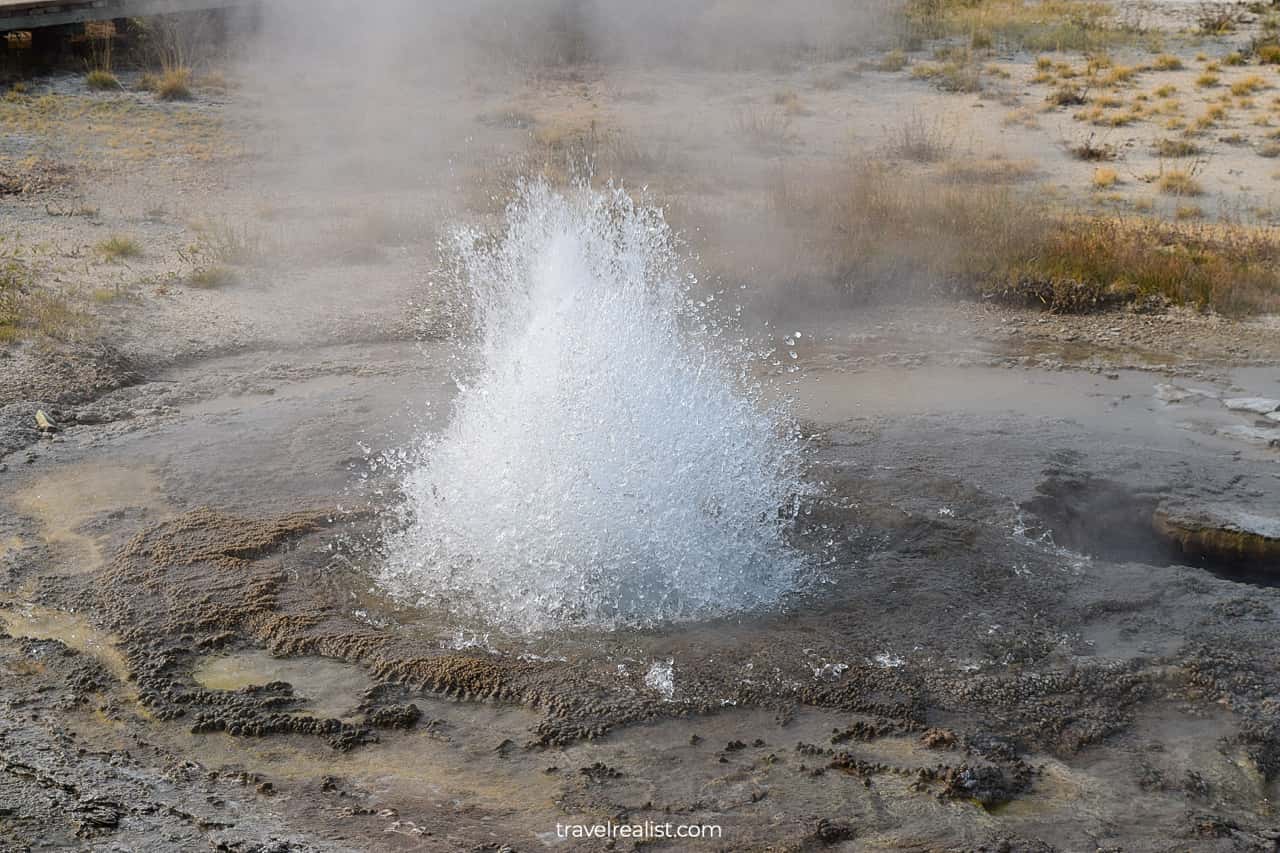
Emerald Pool
Even the names of the Black Basin’s hot springs are picturesque. Think about the Sunset Lake, Rainbow Pool, Handkerchief Pool, or Emerald Pool. As this Yellowstone Guide points out repeatedly, visiting all sights will quickly result in falling behind schedule and running out of daytime.
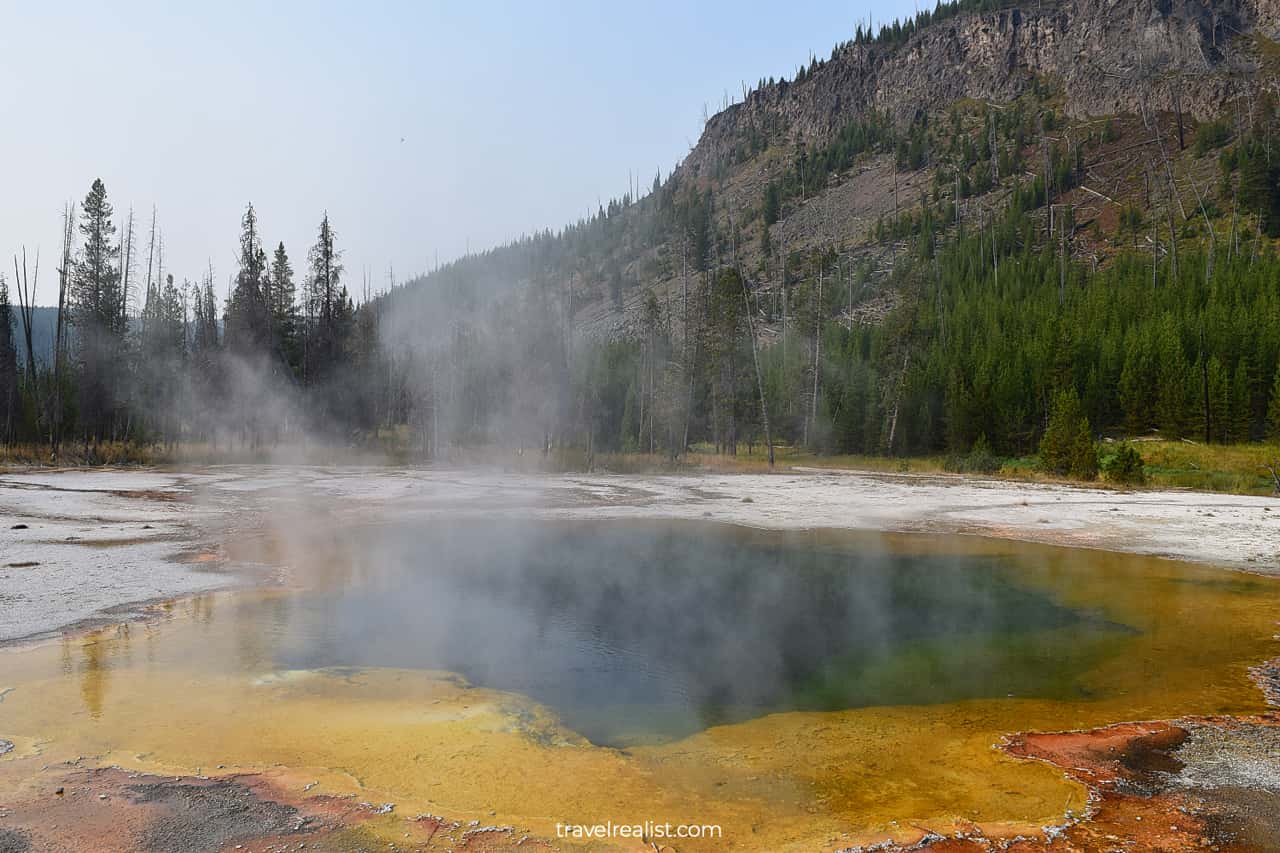
Biscuit Basin
So it was time to go. Five minutes later we were at the Biscuit Basin. This basin was very active during our visit. It seemed as if every pool was releasing steam.
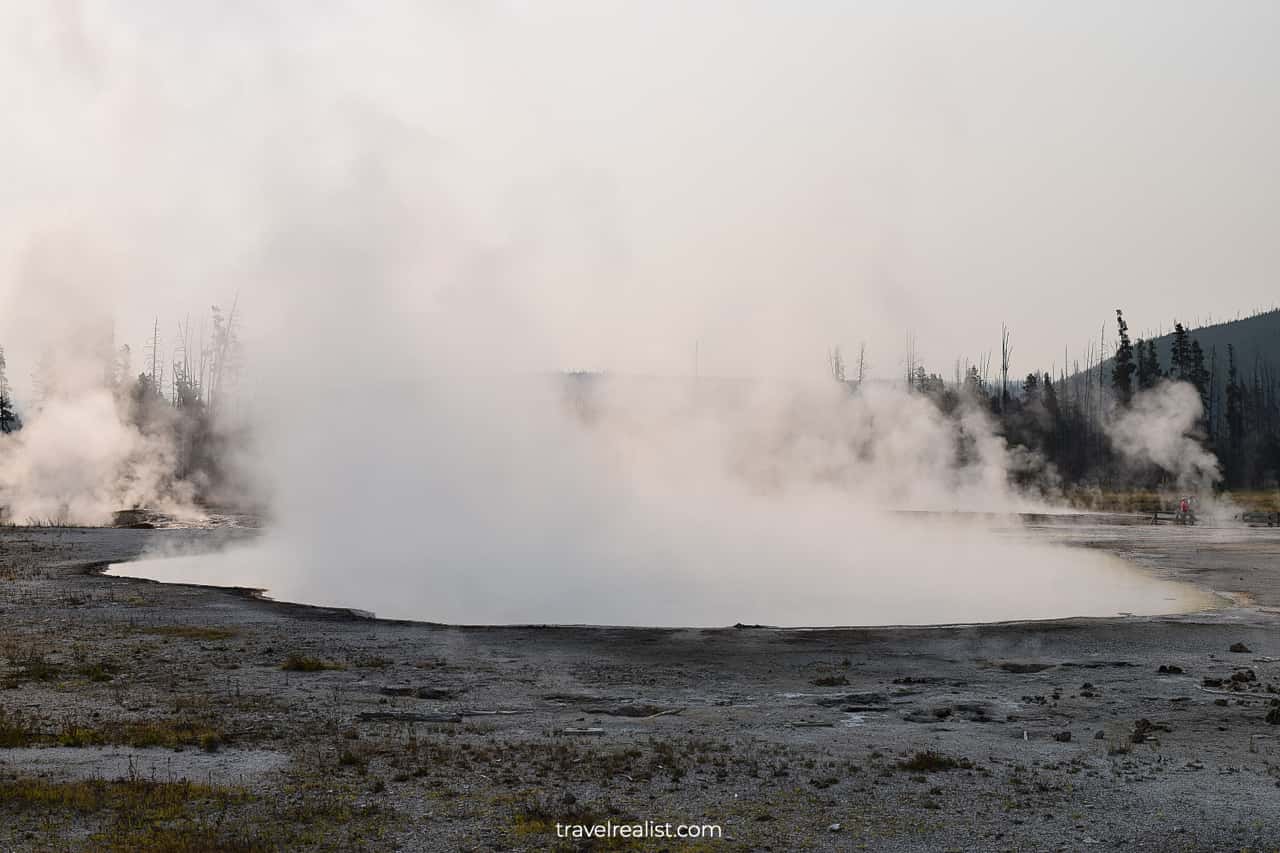
Sapphire Pool
The Biscuit Basin is known for the Sapphire Pool. This deep blue hot spring lives up to its poetic name.
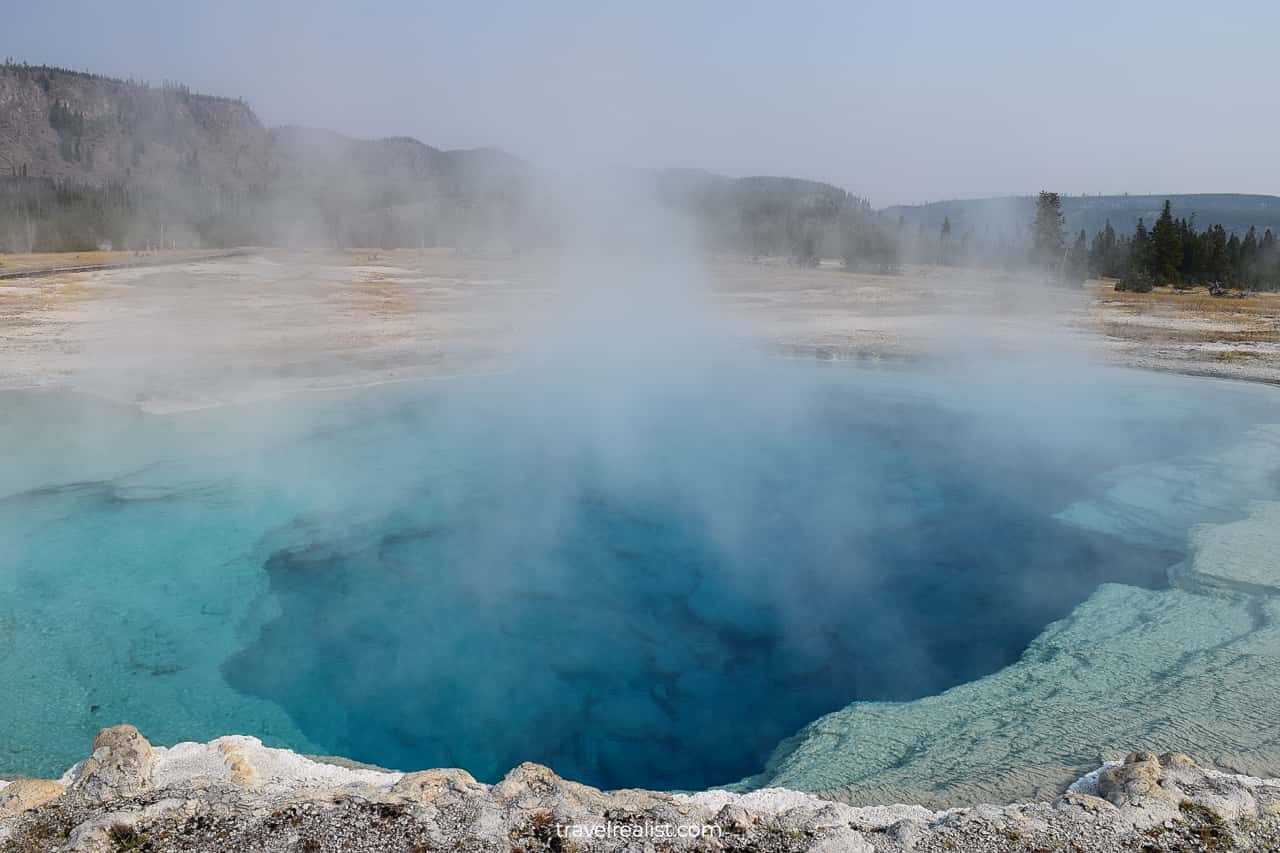
Jewel Geyser
While we were exploring the Biscuit Basin, we stumbled upon the Jewel Geyser‘s eruption. You can capture things in Yellowstone if you are in the right place at the right time.
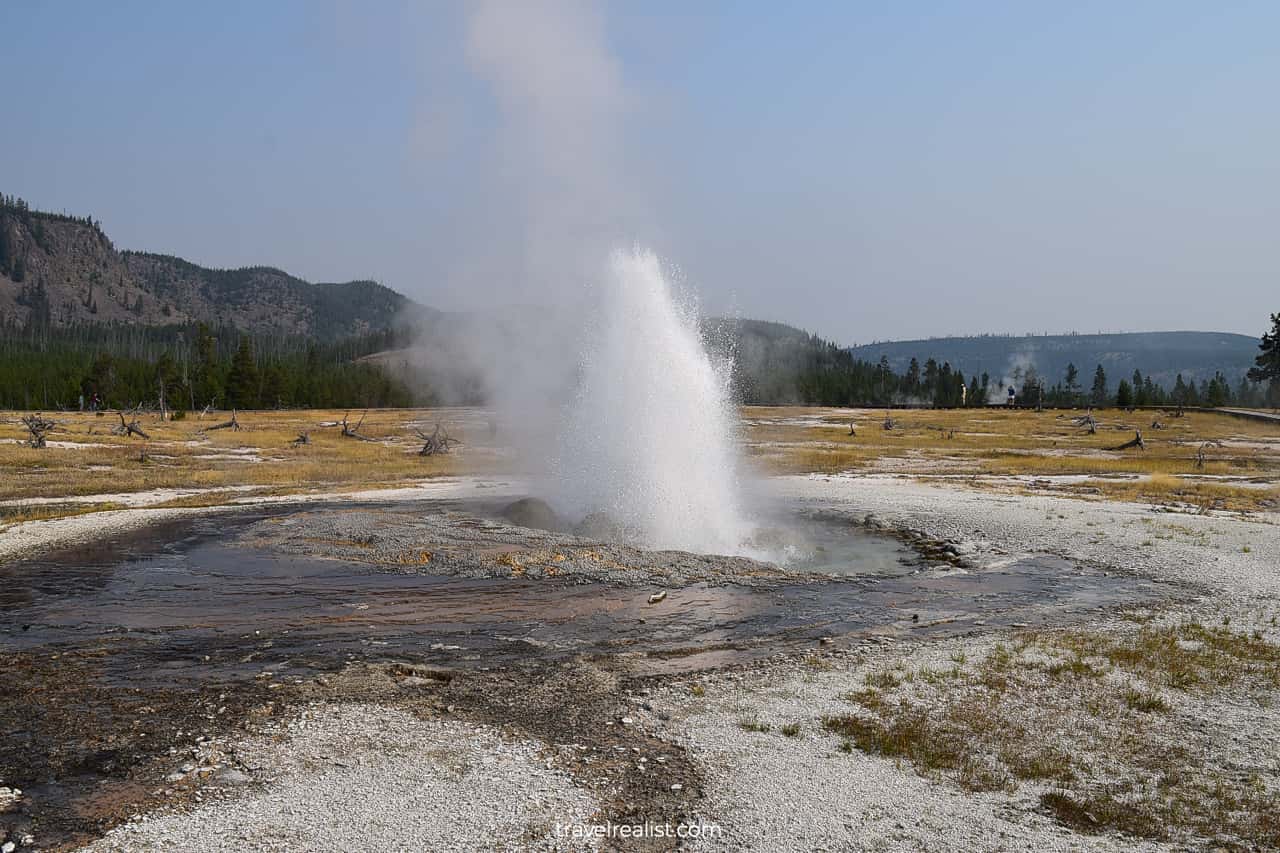
Midway Geyser Basin
We made a difficult choice to not hike 2.5 miles (4 km) return hike to the Mystic Falls. Instead, we proceeded to the Midway Geyser Basin.
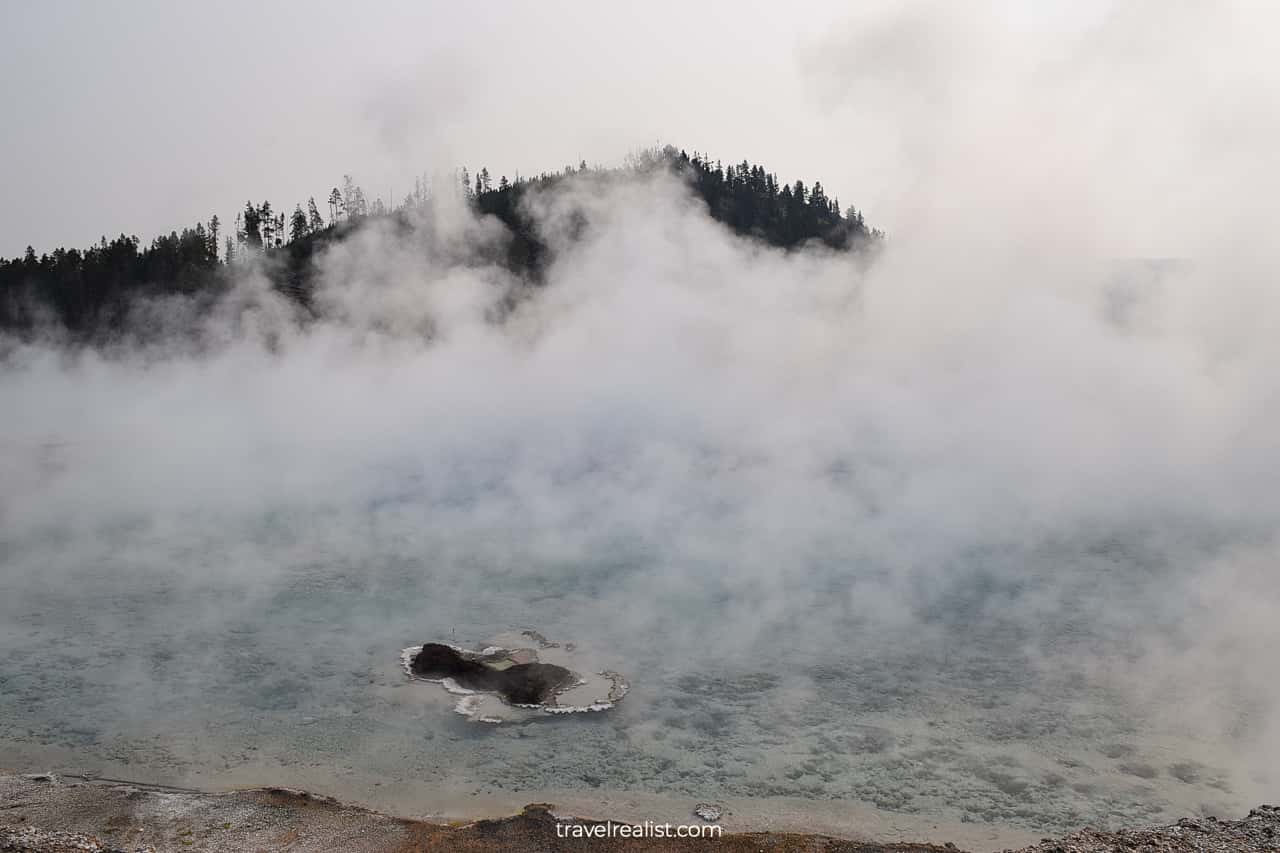
This basin features the Grand Prismatic Spring, another iconic Yellowstone formation. The parking lot is tiny compared to the number of visitors it receives. No matter when you arrive, prepare for a lengthy search for a parking spot.
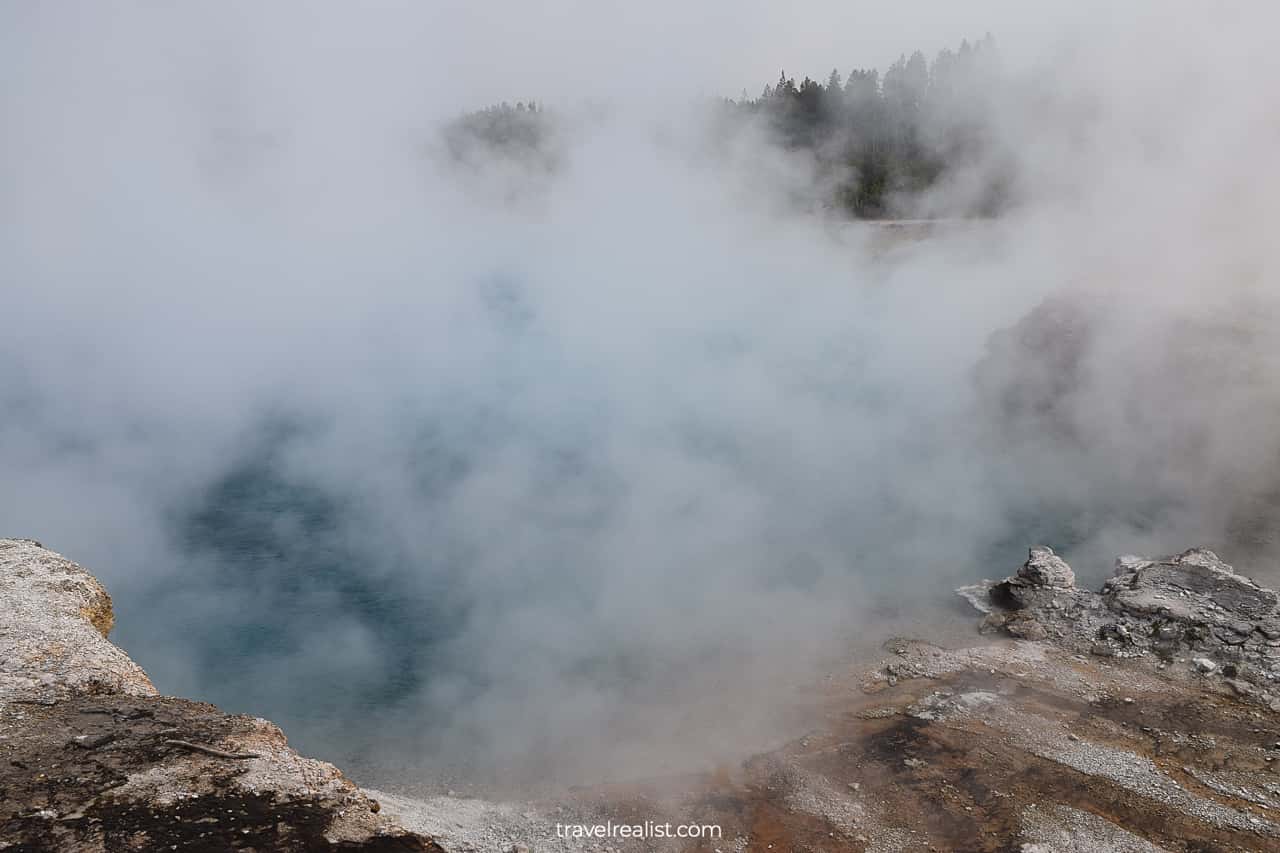
Grand Prismatic Spring
The Grand Prismatic Spring in its full beauty. Its color palette is just mind-blowing.
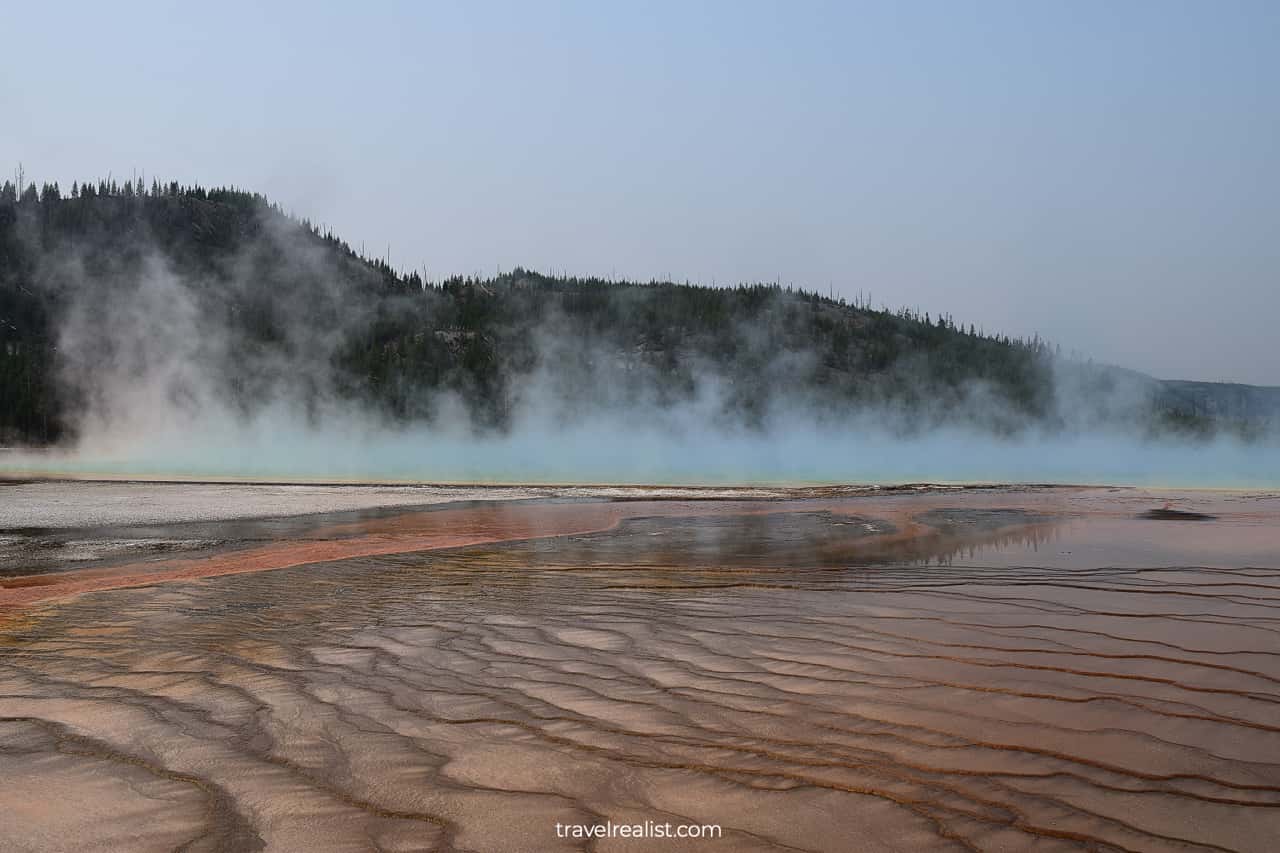
There is a hike to the top of the hill that provides an iconic view of the spring from atop. The hike starts at the Fairy Falls Trailhead and covers 1.6 miles (2.5 km) round trip.
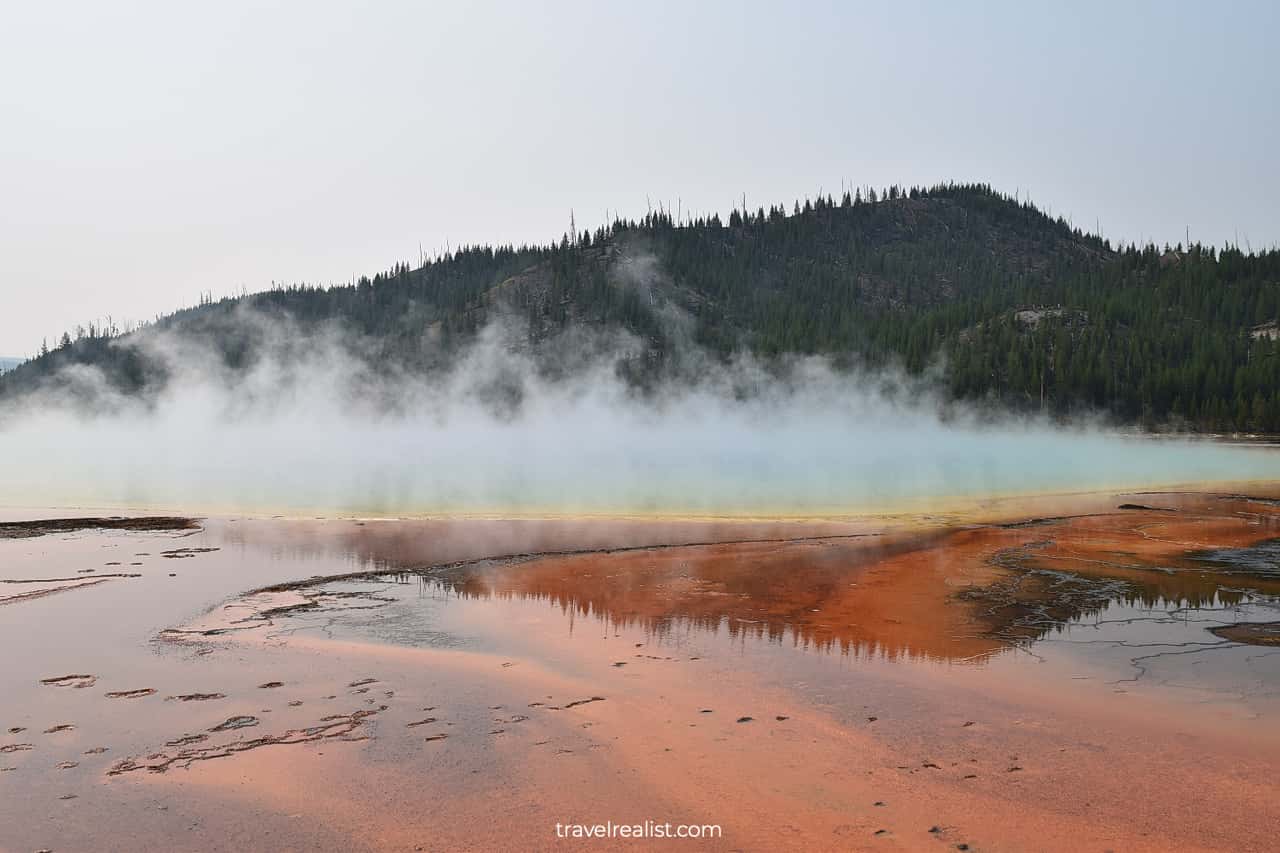
Firehole River
The Midway Geyser Basin’s hot springs flow into the Firehole River. This river connects Old Faithful, Biscuit, and Midway Geyser Basins.
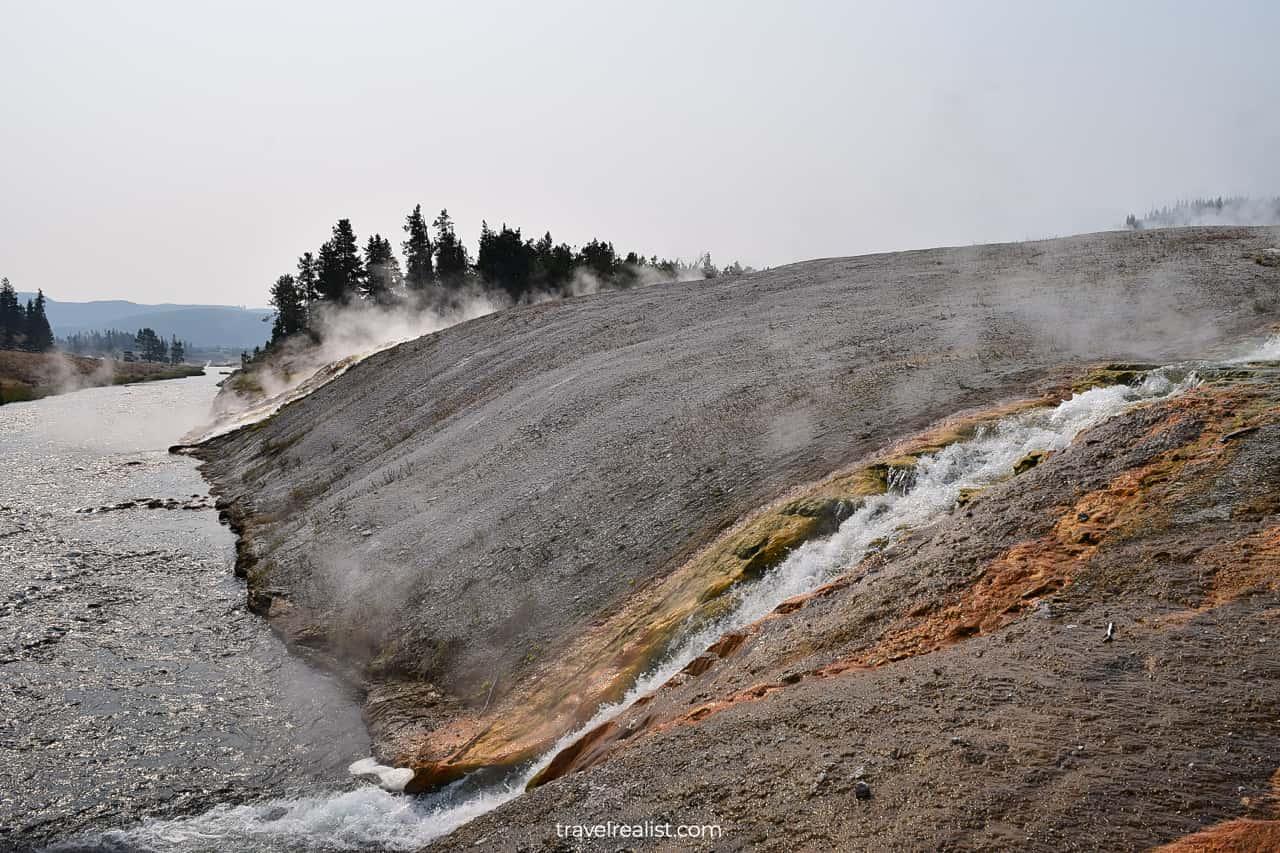
Firehole Lake Drive
The Firehole Lake Drive is a one-way scenic drive just past the Midway Geyser Basin. It features a few more geysers, hot springs, pools, and creeks. If you visit the Hot Lake during a cold morning, you will experience a steam release from the entire lake’s surface.
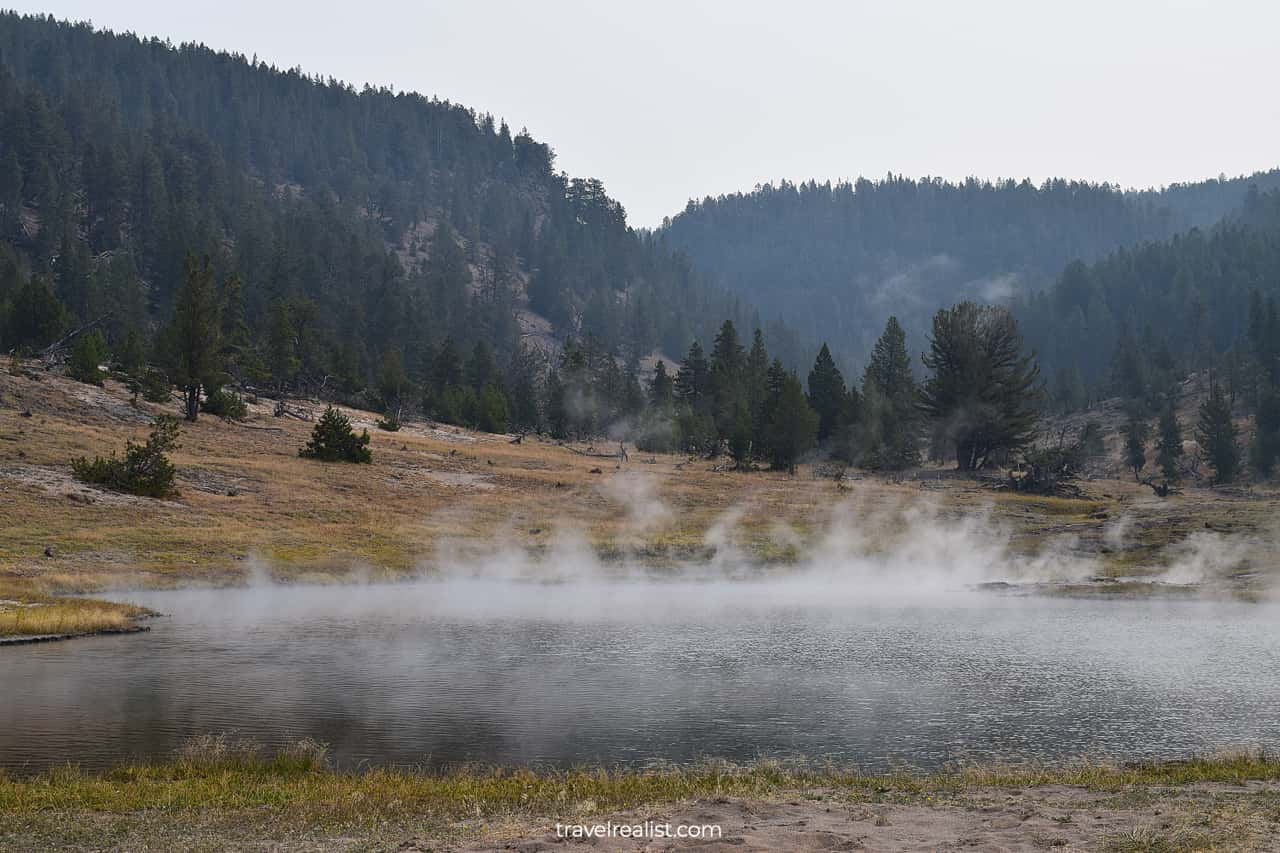
Firehole Canyon Drive
Next, we turned on an another one-way drive, the Firehole Canyon Drive.
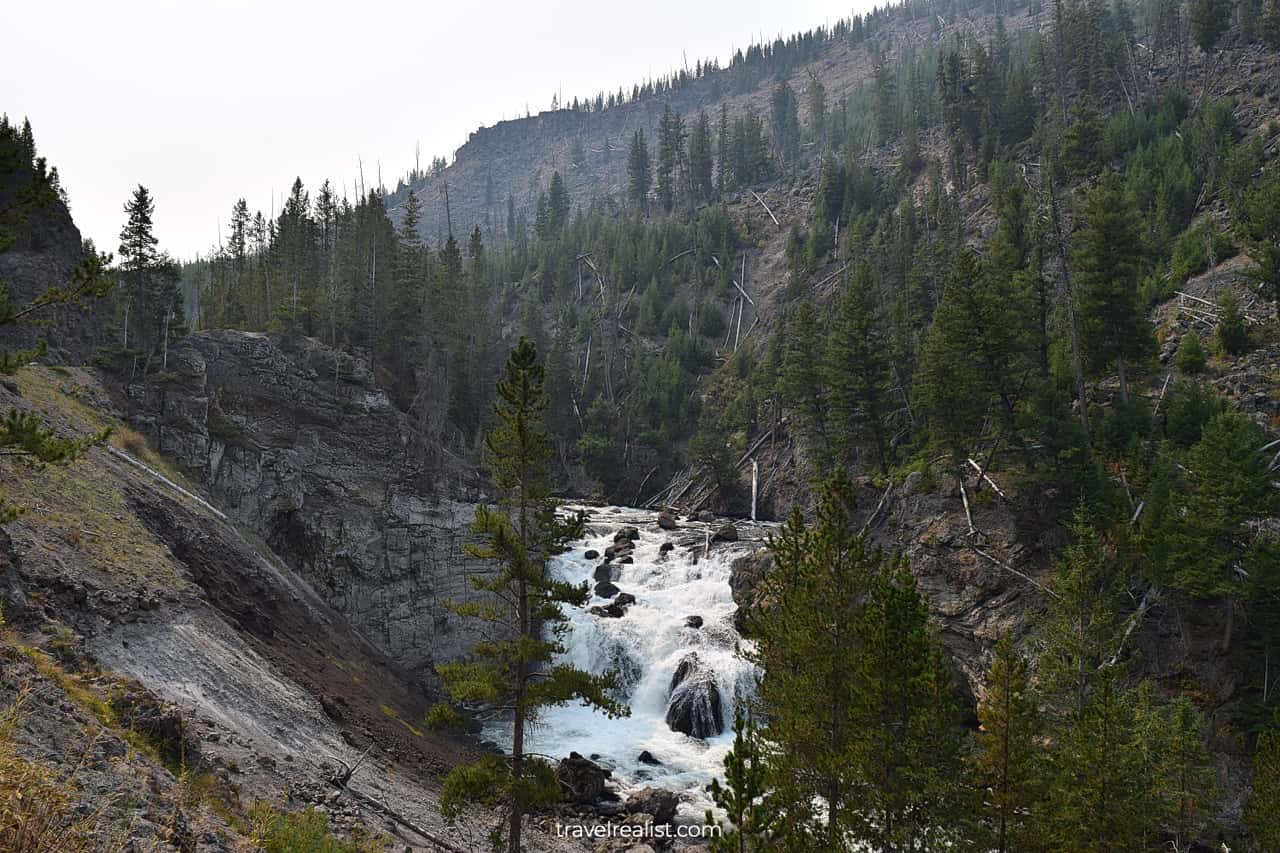
The drive is scenic but narrow. It would benefit from some extra care. Most overlooks on the Drive lacked tarmac.
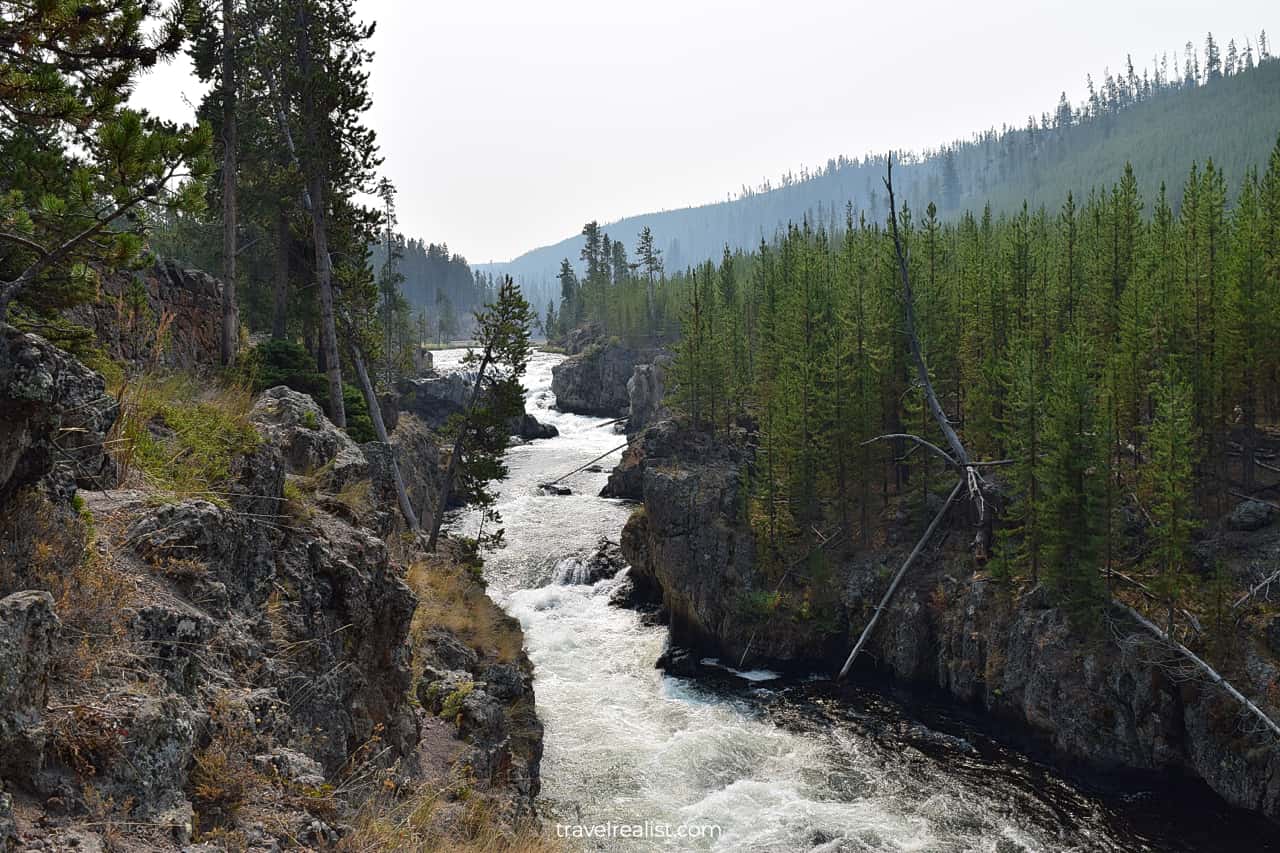
Gibbon Falls
The Firehole Drive brought us to Madison Road Junction. We turned east on Highway US-89, while Highway US-191 continued to Idaho. Gibbon Falls was the first place of interest after the highway intersection.
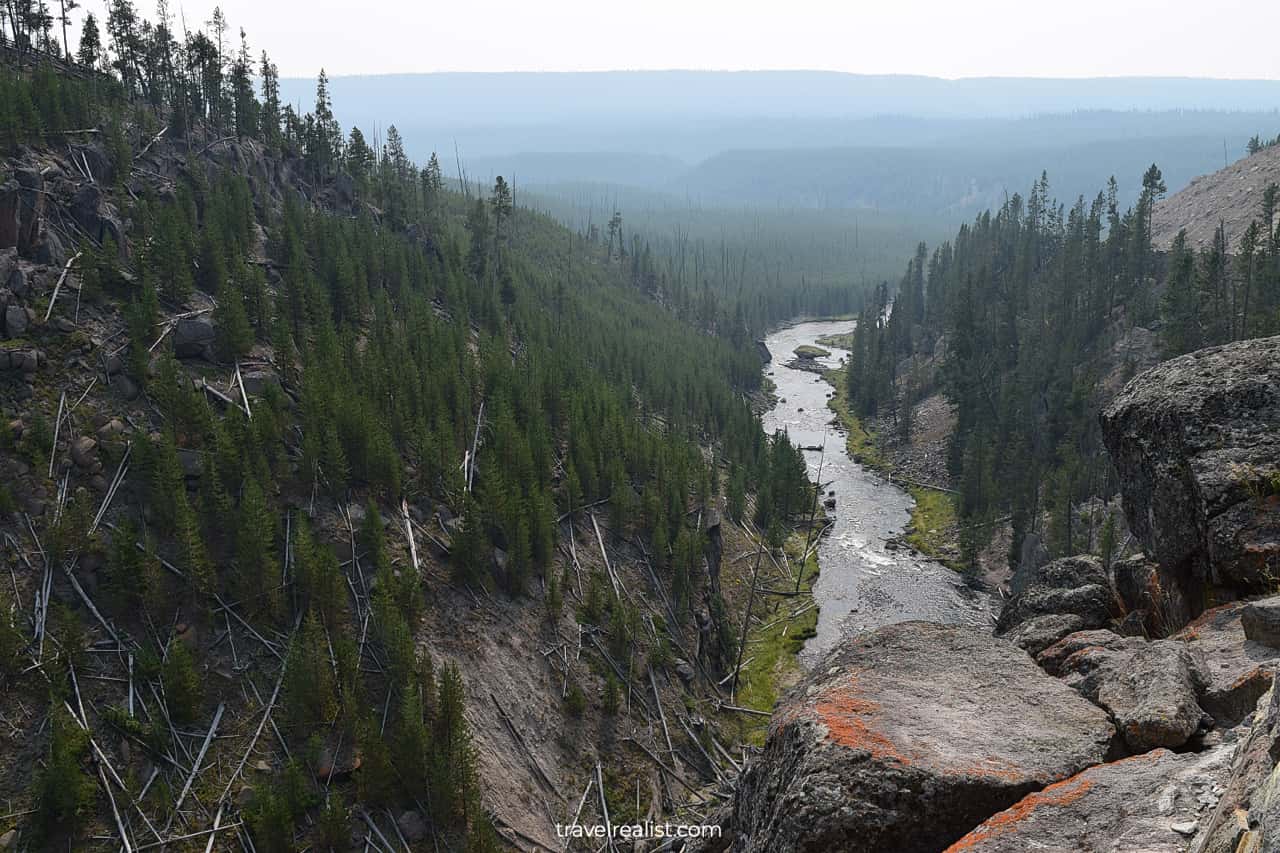
Norris Geyser Basin
For almost 20 minutes after the Gibbon Falls we only saw occasional formations. One gets spoiled with views quickly in Yellowstone. But the whole landscape changed when we arrived at the Norris Geyser Basin.
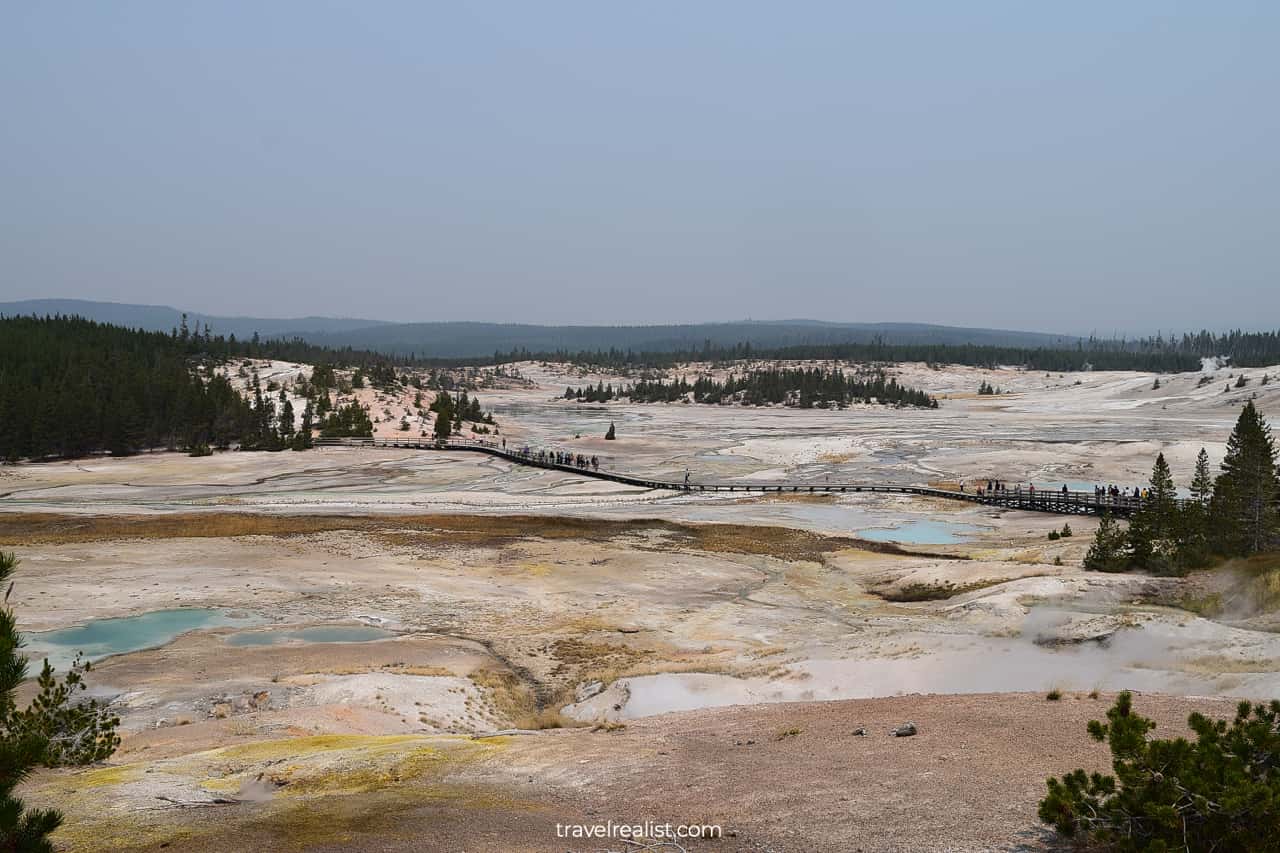
This basin has several hot springs, lakes, and geysers. But the mud pools might be this basin’s unique feature. The Norris Geyser Basin is massive. The boardwalks cover almost 3 miles (5 km) between the basin’s attractions.
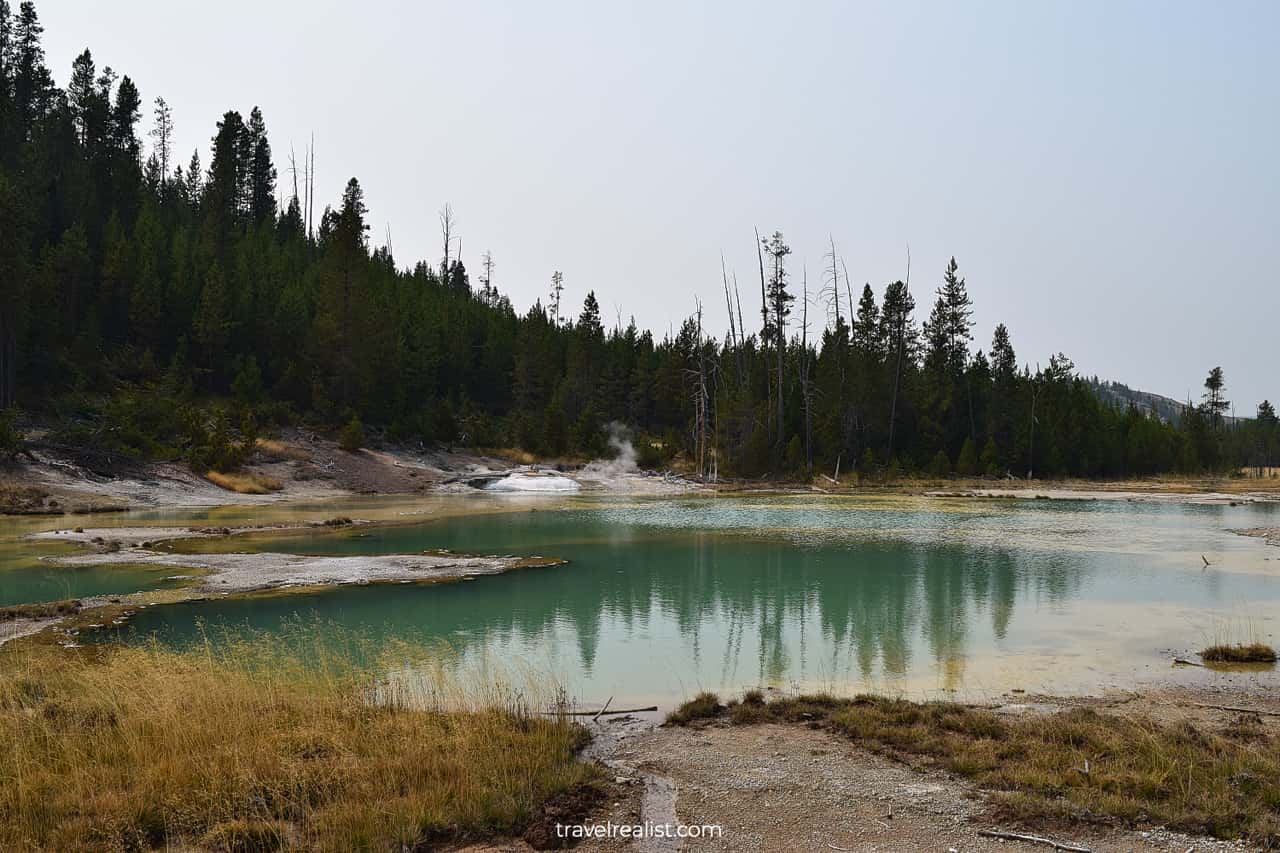
Roaring Mountain
Norris Geyser Basin is located at the intersection of Grand, Upper, and Lower Yellowstone Loops. Our Yellowstone Guide continues on the Grand Loop Road towards the Mammoth Hot Springs. This area of the park was a bit less scenic. The Roaring Mountain is one of the few attractions. See if you can spot steam coming from the mountain.
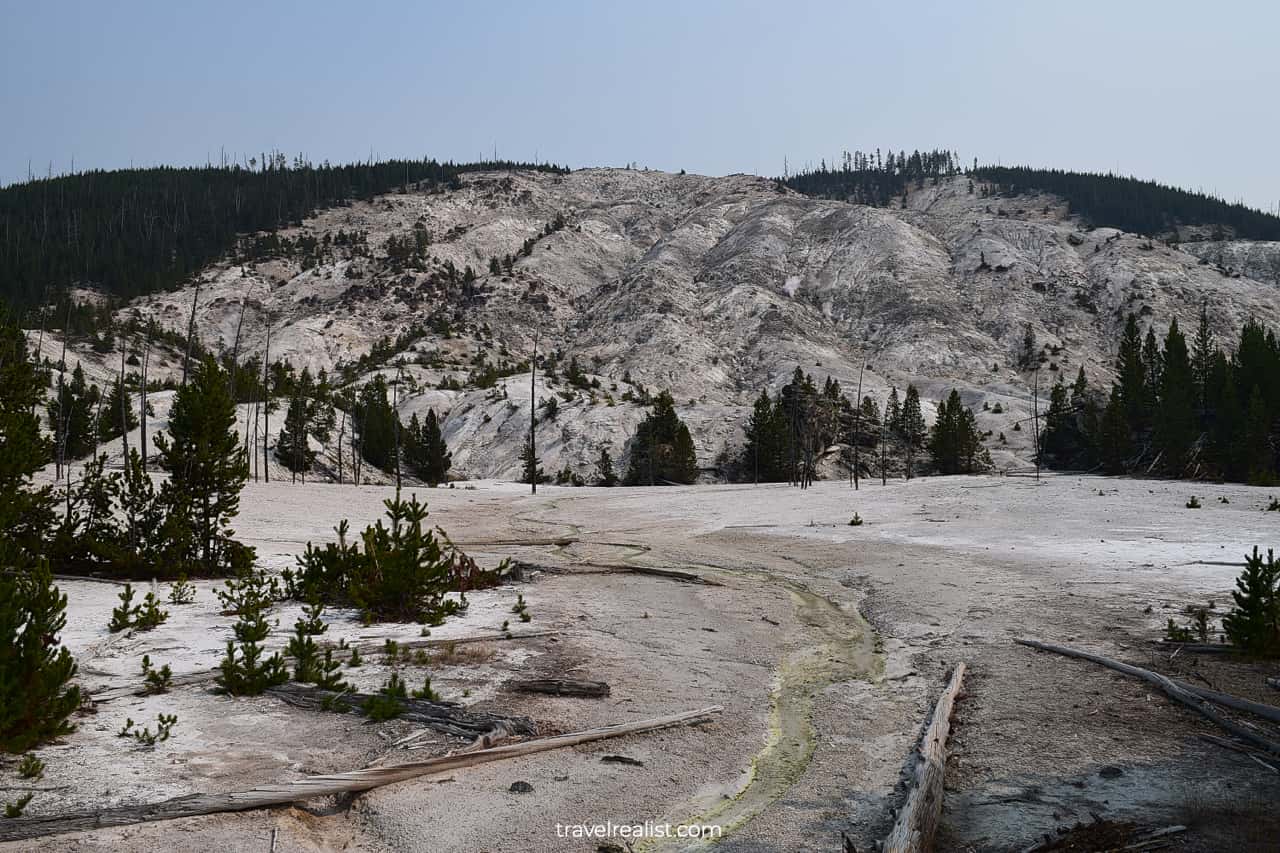
Mammoth Hot Springs
On the other hand, the Mammoth Hot Springs area is worth a visit. It consists of Upper and Lower terraces with springs and formations. We first took a one-way Upper Terrace Loop Drive.
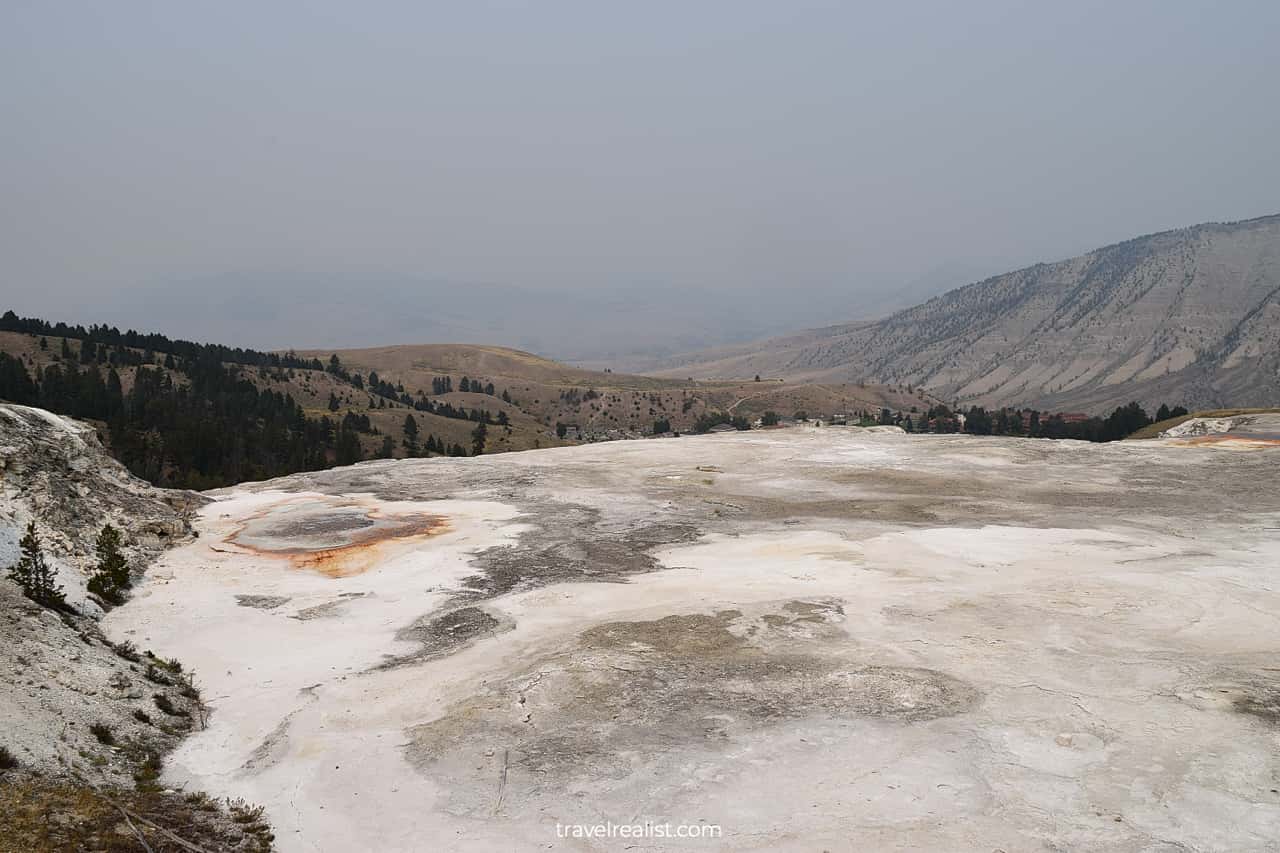
Upper Terraces
A well maintained trail connects both terraces. It might be easiest to stop at one of the first overlooks on the Upper Terrace Loop Drive. You could then take a short hike downhill and enjoy the terrace’s full beauty.
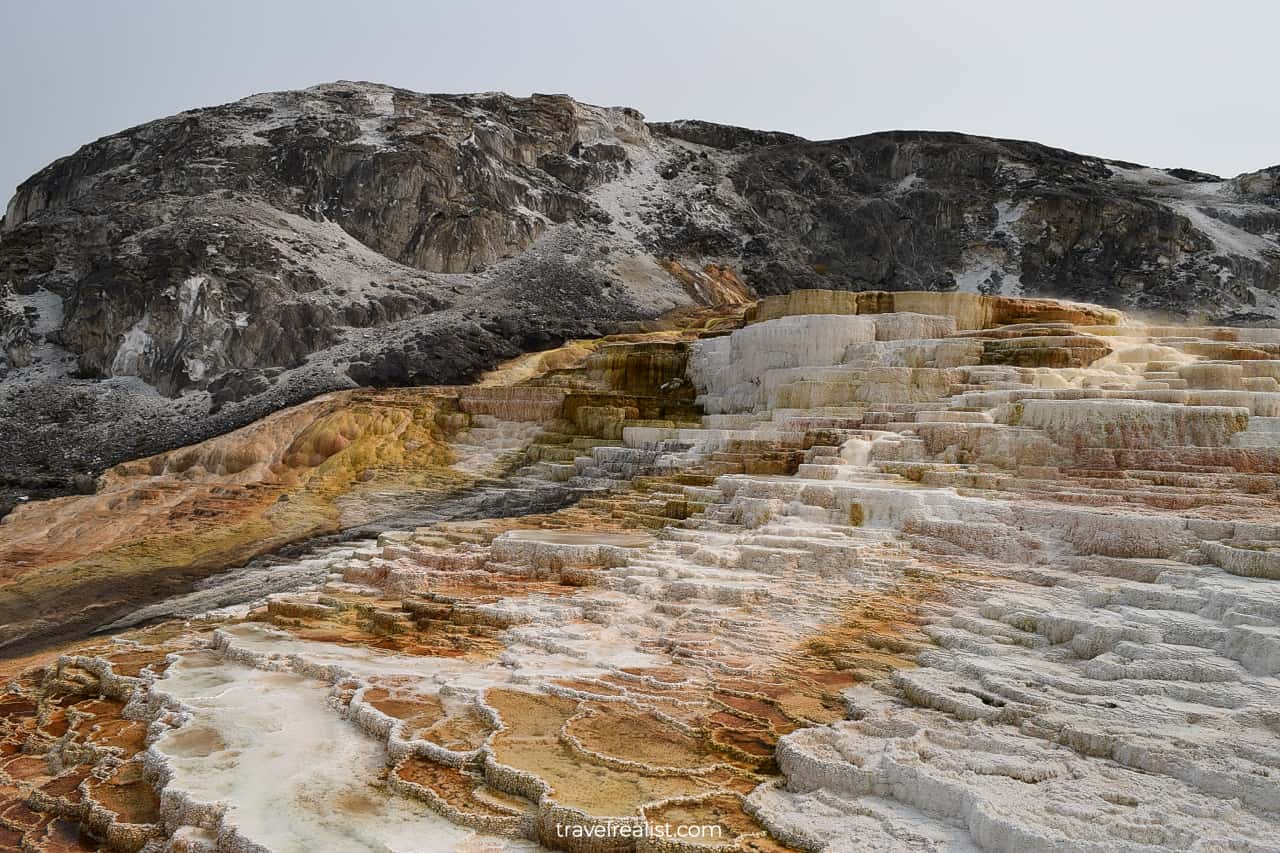
The Mammoth Hot Springs area makes it easy to understand the origins of the park’s name. There are a lot of yellow stones on the terraces. Of course, other colorful formations are also in abundance there.
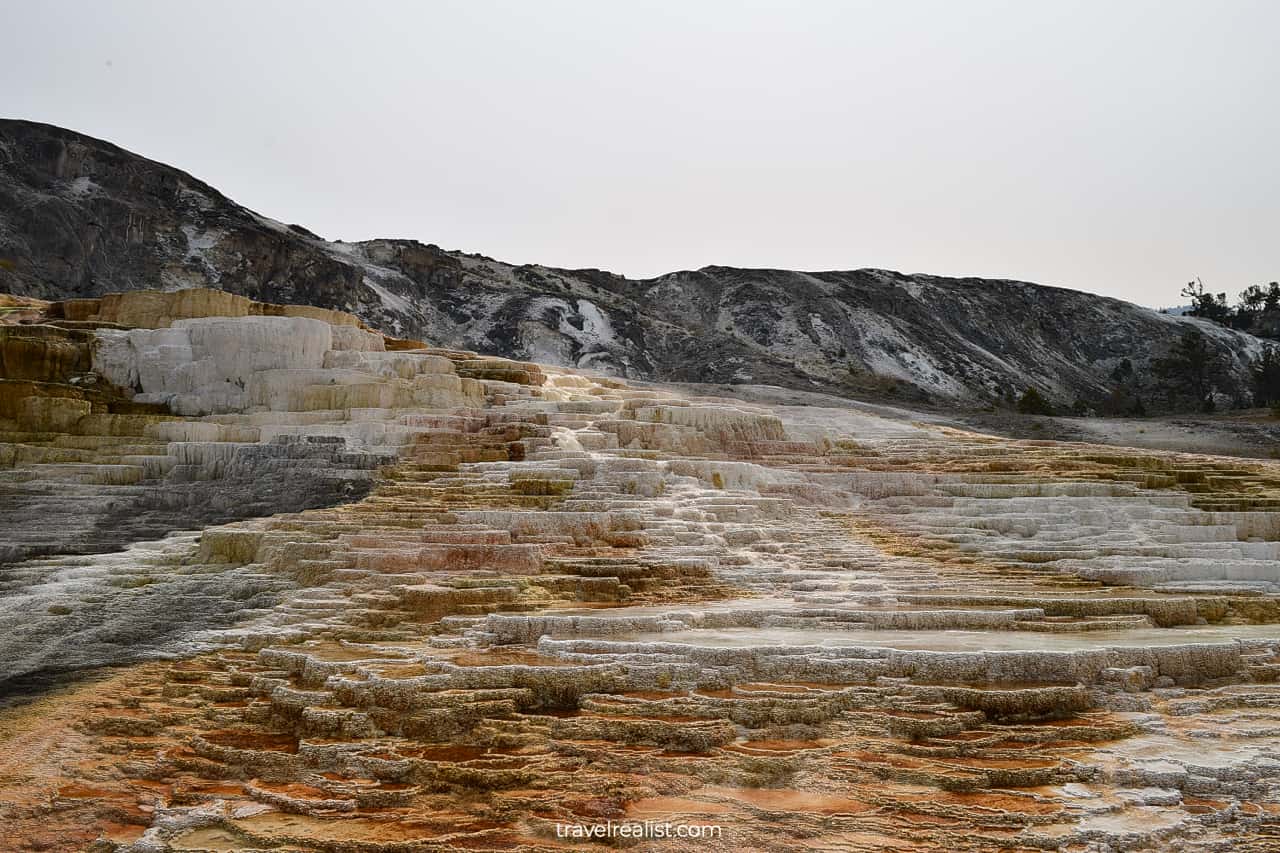
White Elephant
The rest of the Upper Terrace Loop Drive has different type of terraces. And it features a few other notable formations. For example, this is the White Elephant terrace.
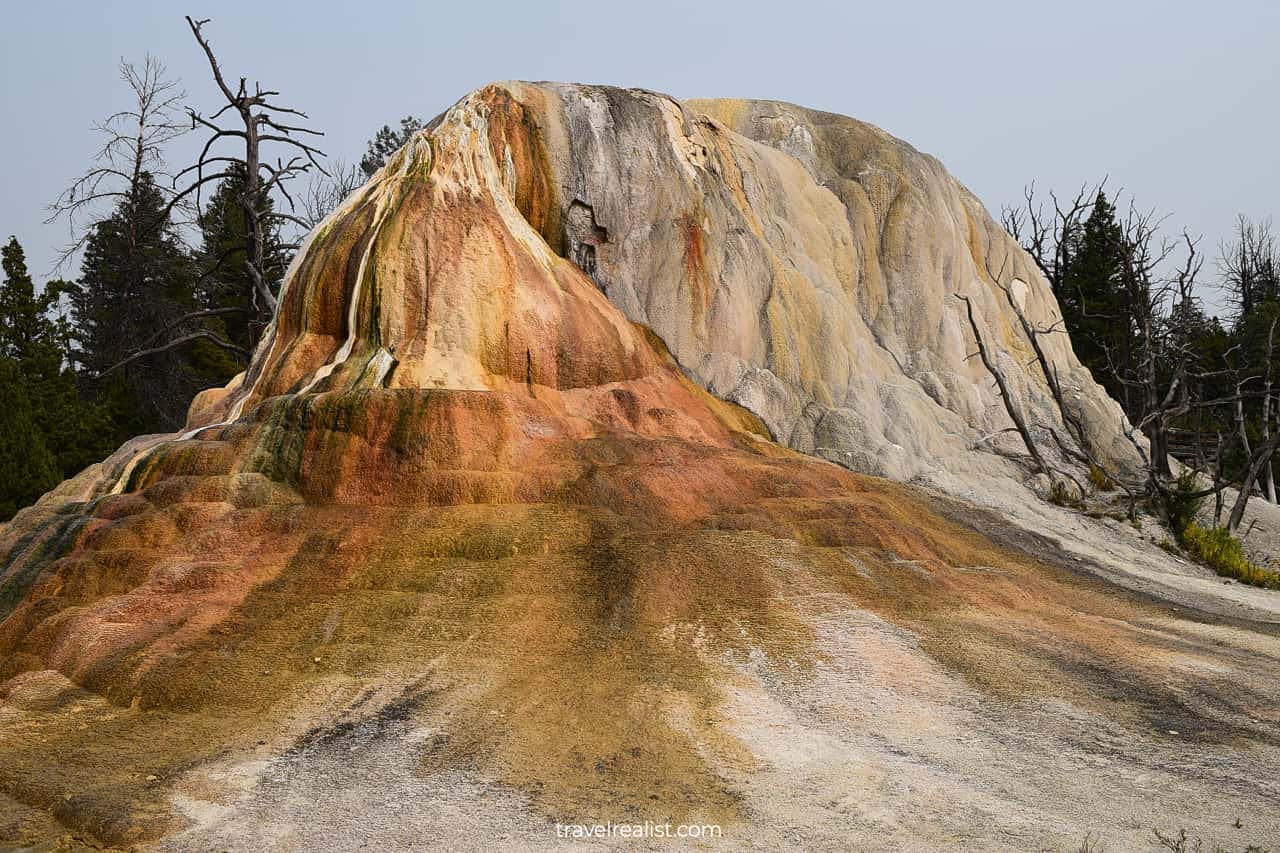
Aphrodite Terrace
White and grey minerals completely covered the ground at times. It resembled a winter landscape in the middle of summer.
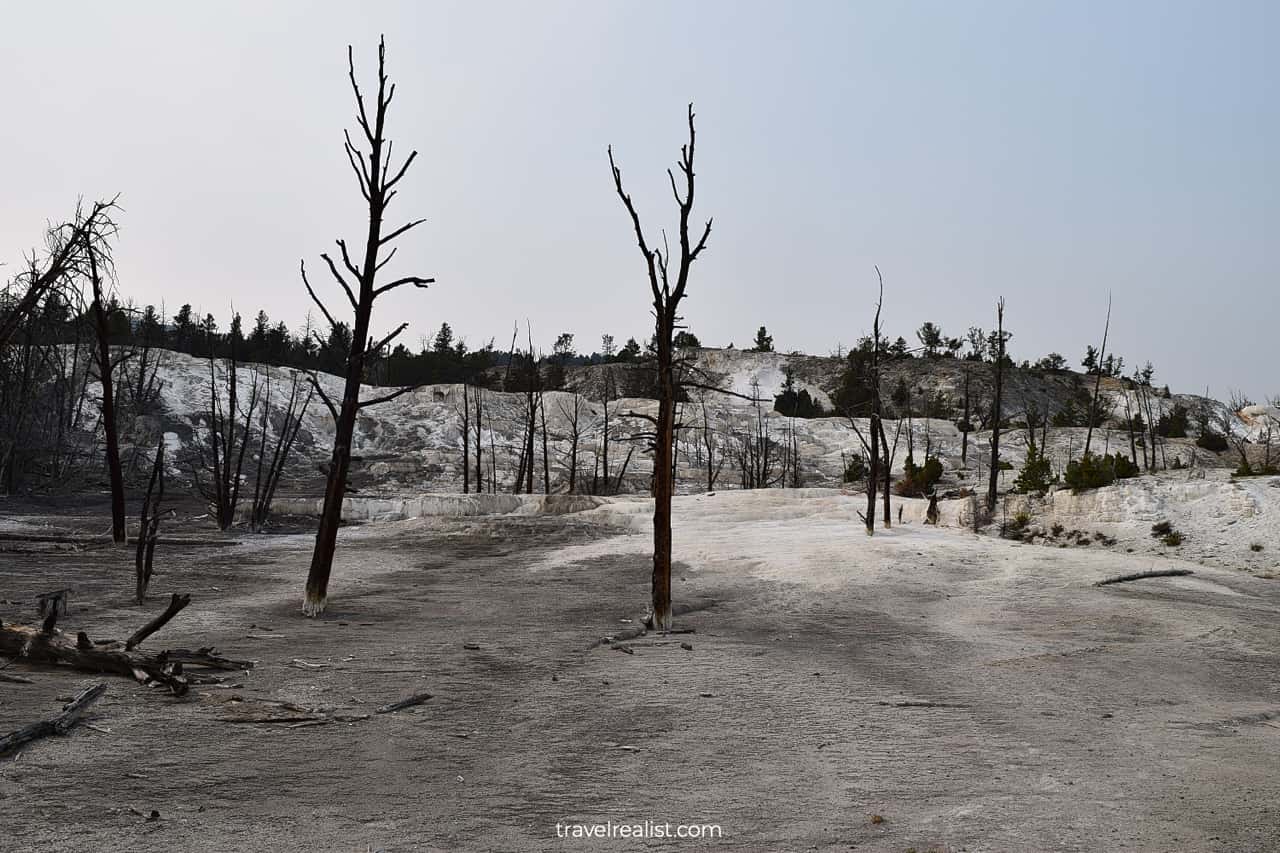
Once we completed the Upper Terrace Loop Drive, we proceeded to the Lower Terraces.
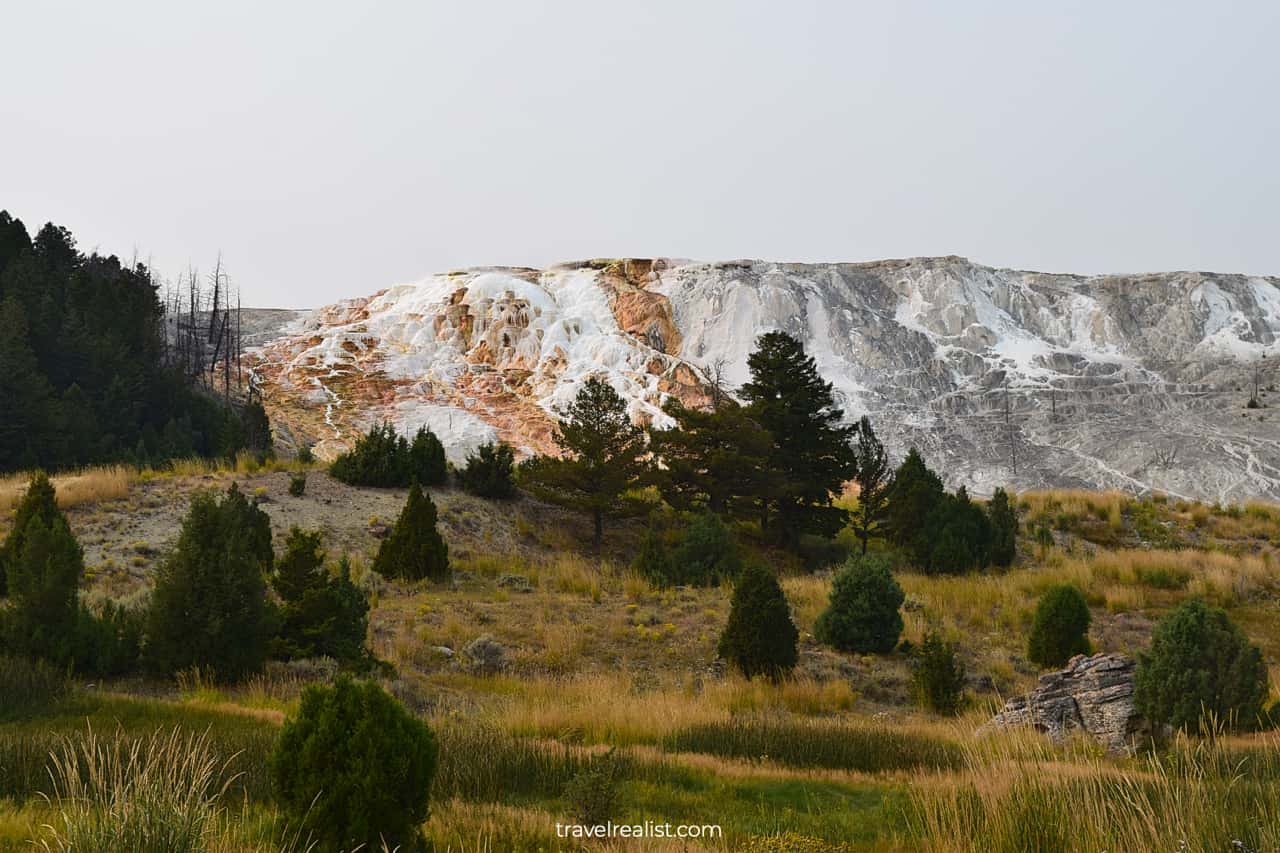
Gardiner River Bridge
Halfway to the Lower Terraces and the visitor center, we stopped at a viewpoint. It provided excellent views of the valley and the Gardiner River Bridge.
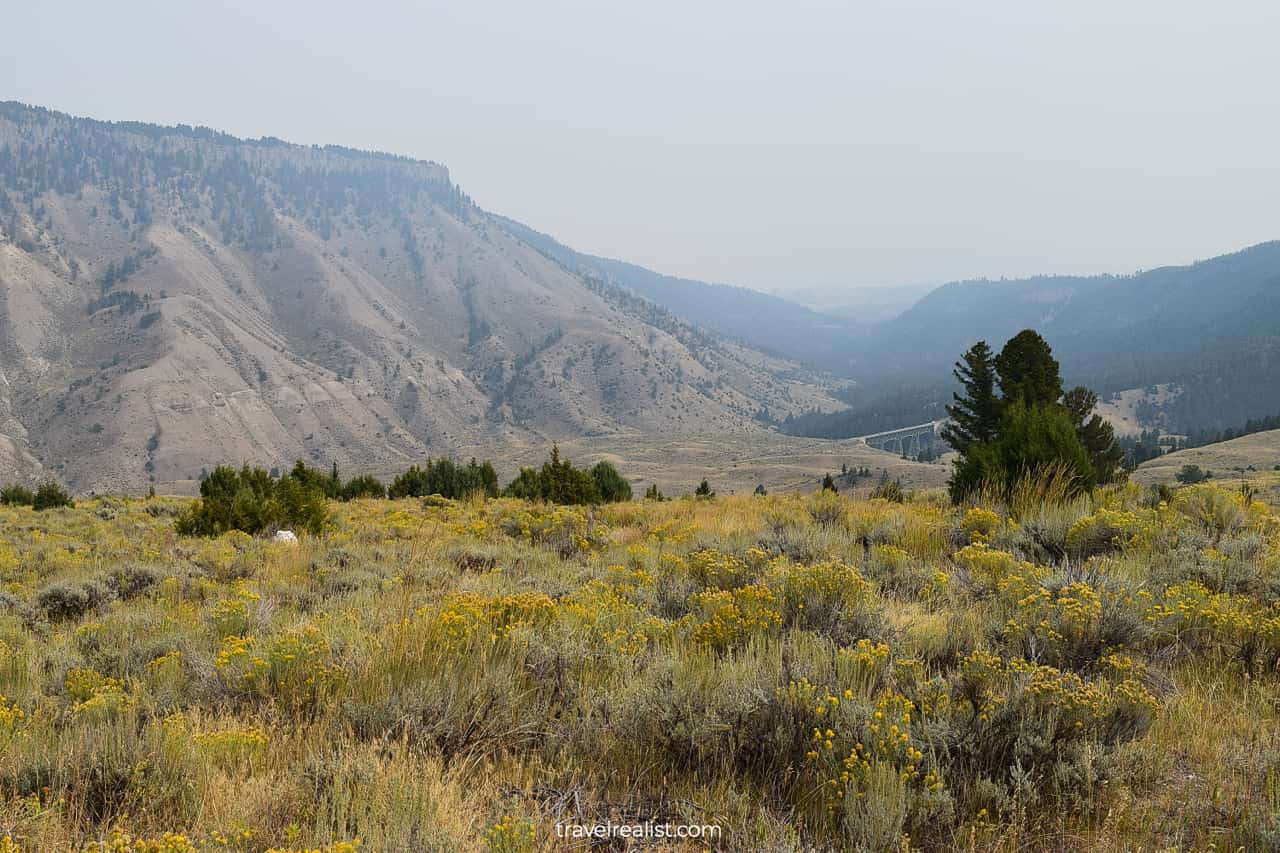
Lower Terraces
The Lower Terraces were just as breathtaking as the Upper ones.
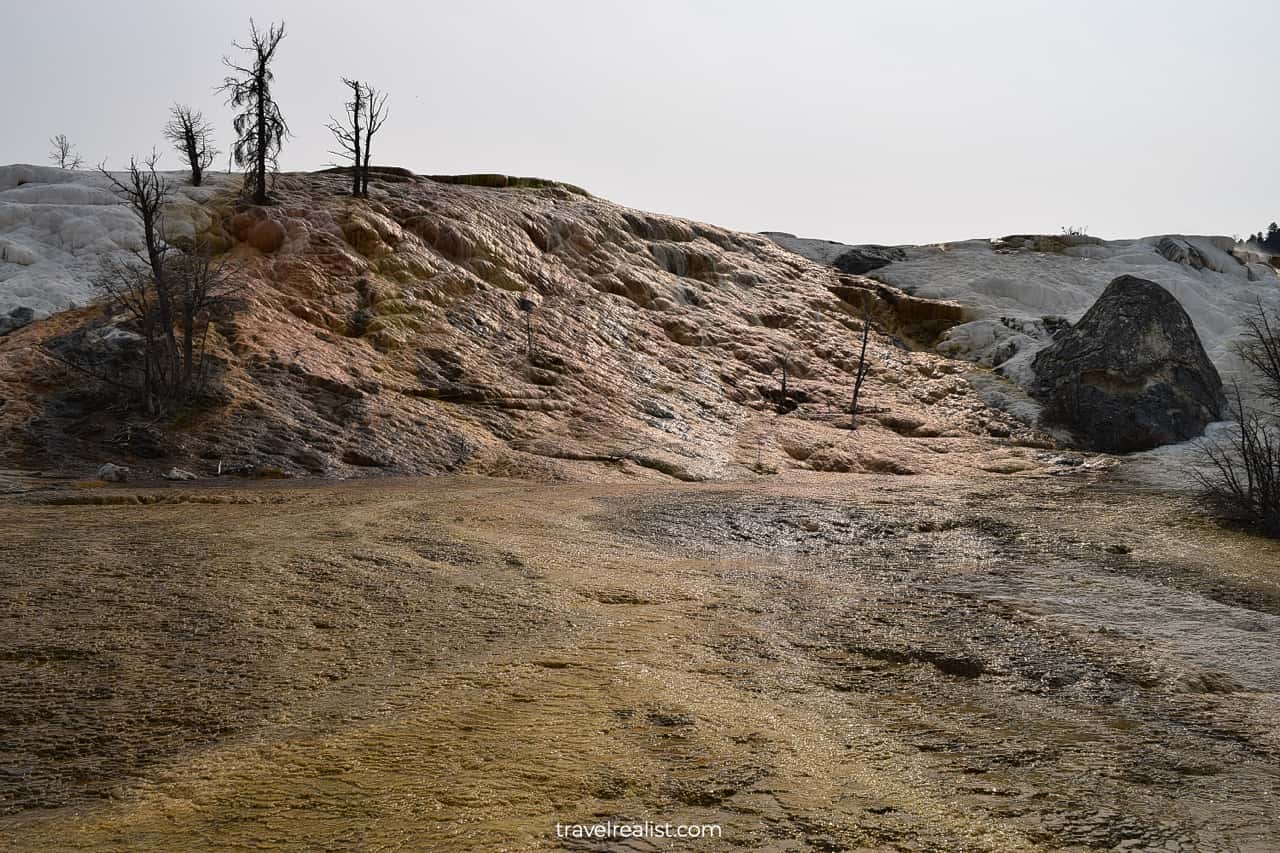
Hot water flow gave the rocks vivid yellow and white colors over the thousands of years.
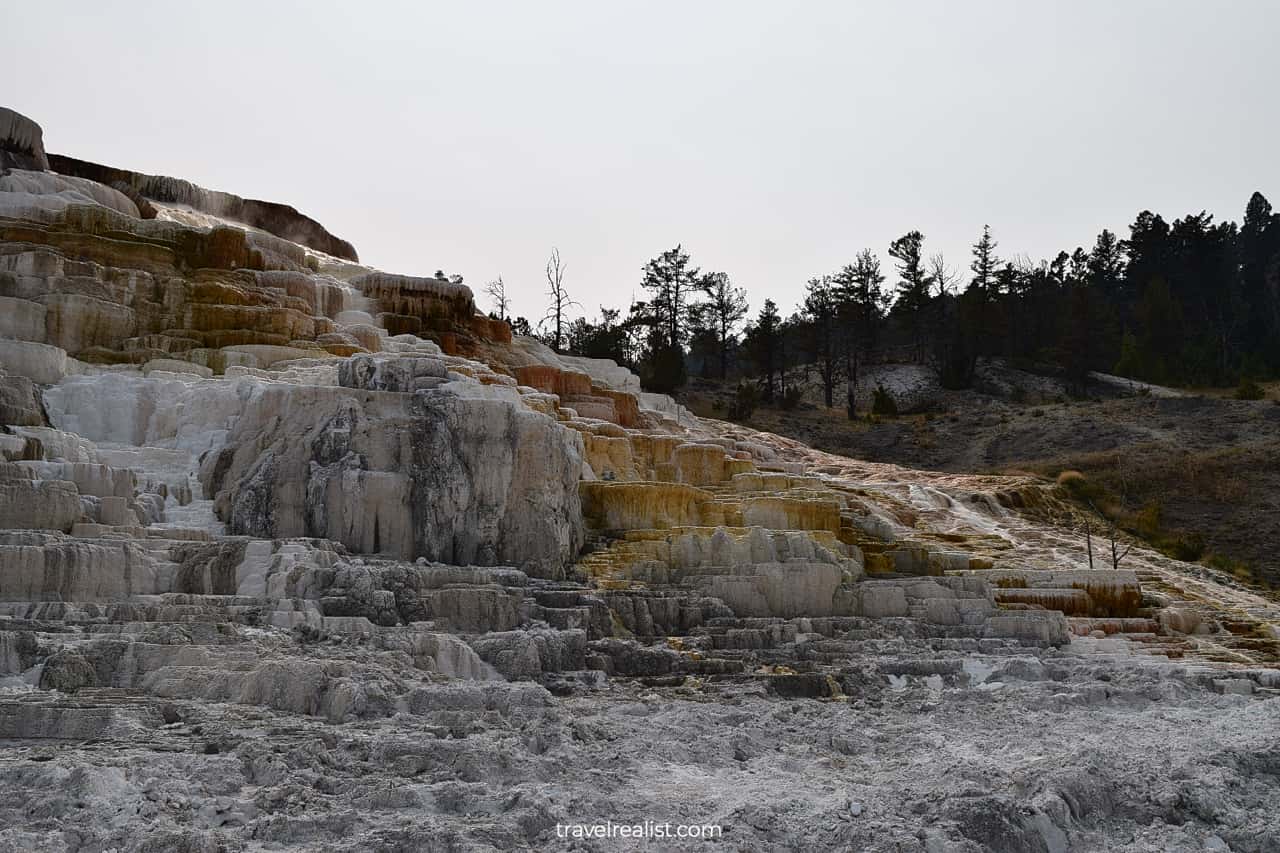
Some springs became dormant and lacked color.

Liberty Cap
The Liberty Cap is a prominent example of a dormant hot springs cone.
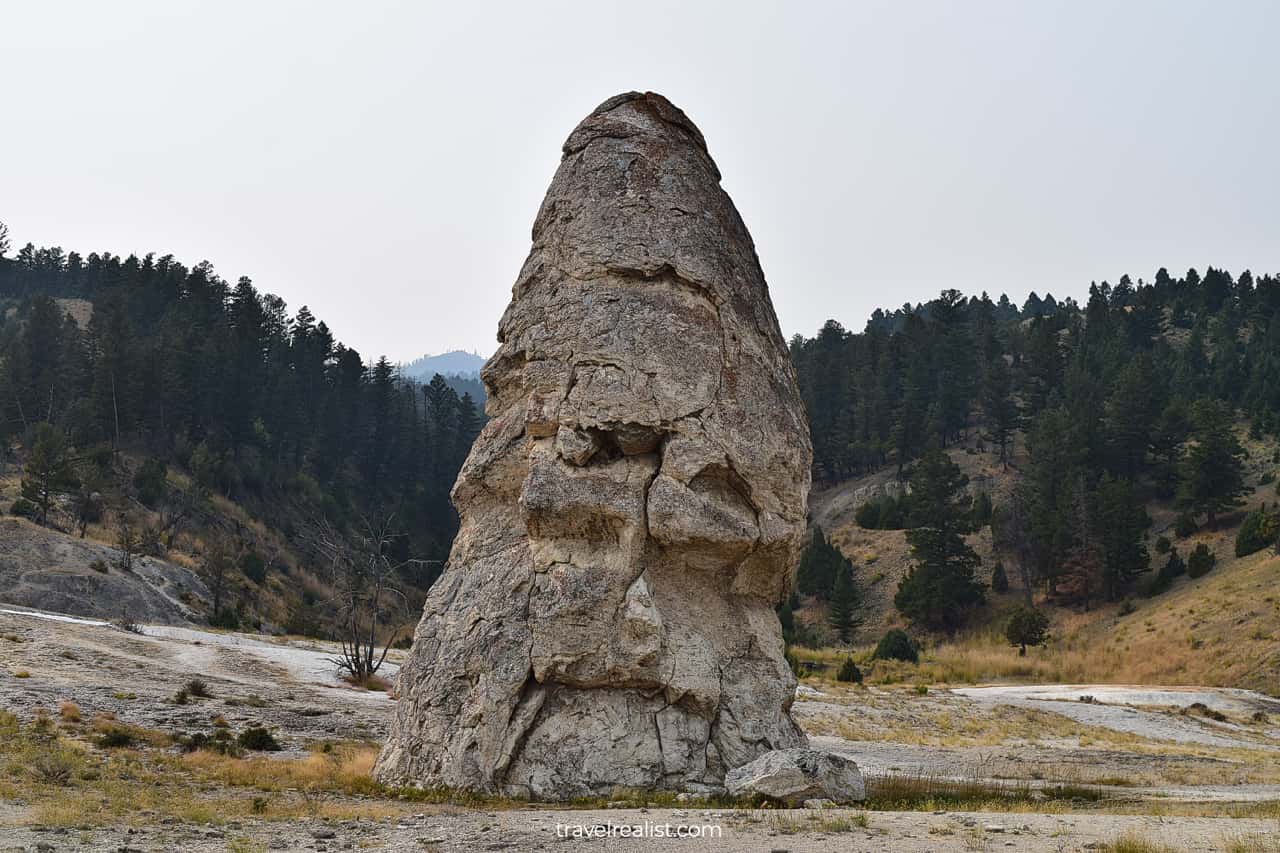
Undine Falls
Mammoth, WY is a few miles (kilometers) away from the Montana state line and the park’s boundary. But we did not want to finish our Yellowstone visit. Instead, we turned west on the Grand Loop Road.
The drive between Mammoth Hot Springs and Tower-Roosevelt features several sights. The Undine Falls were our next stop.
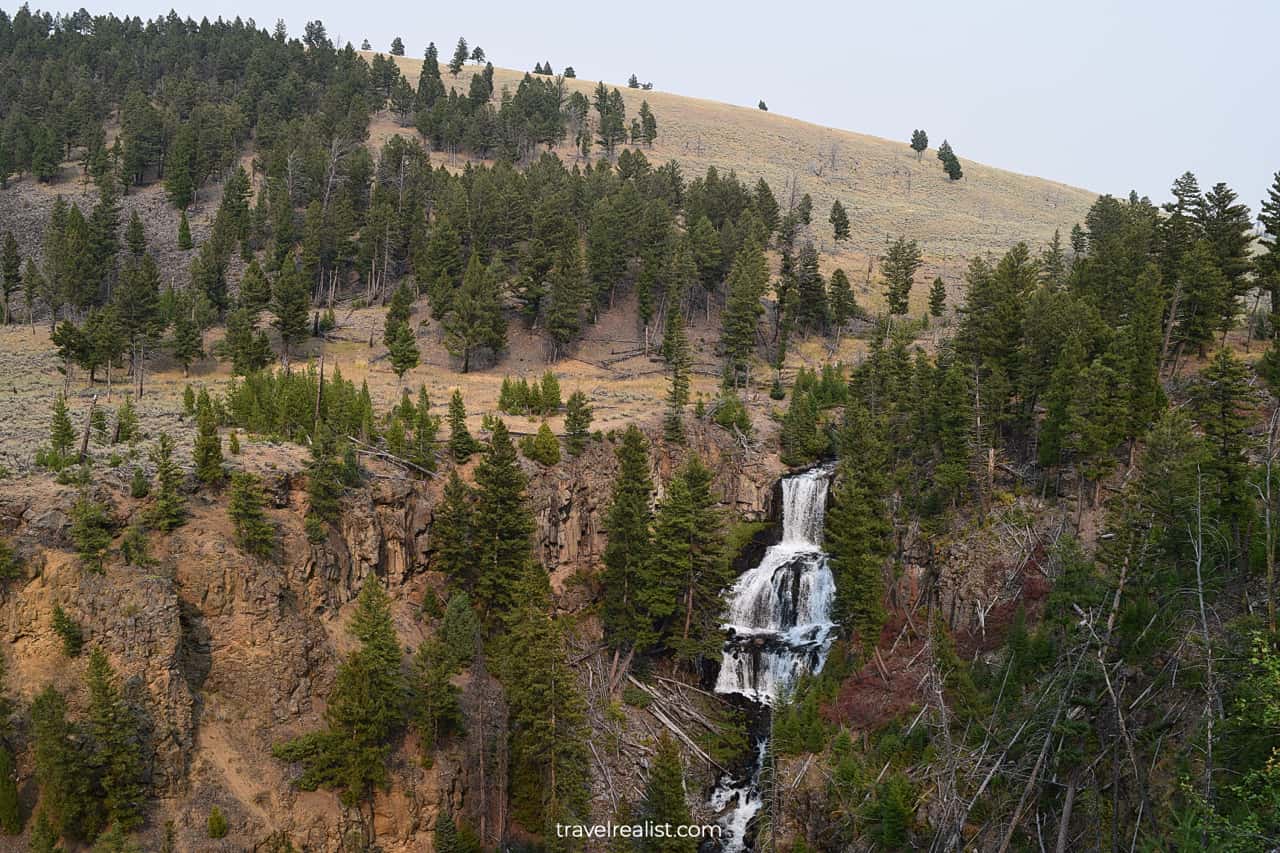
Petrified Tree
For a while we continued driving through the prairies without stopping. It was not until the Petrified Tree that we felt compelled to explore the area more. The Petrified Tree could give the whole Petrified Forest in Arizona a run for its money.
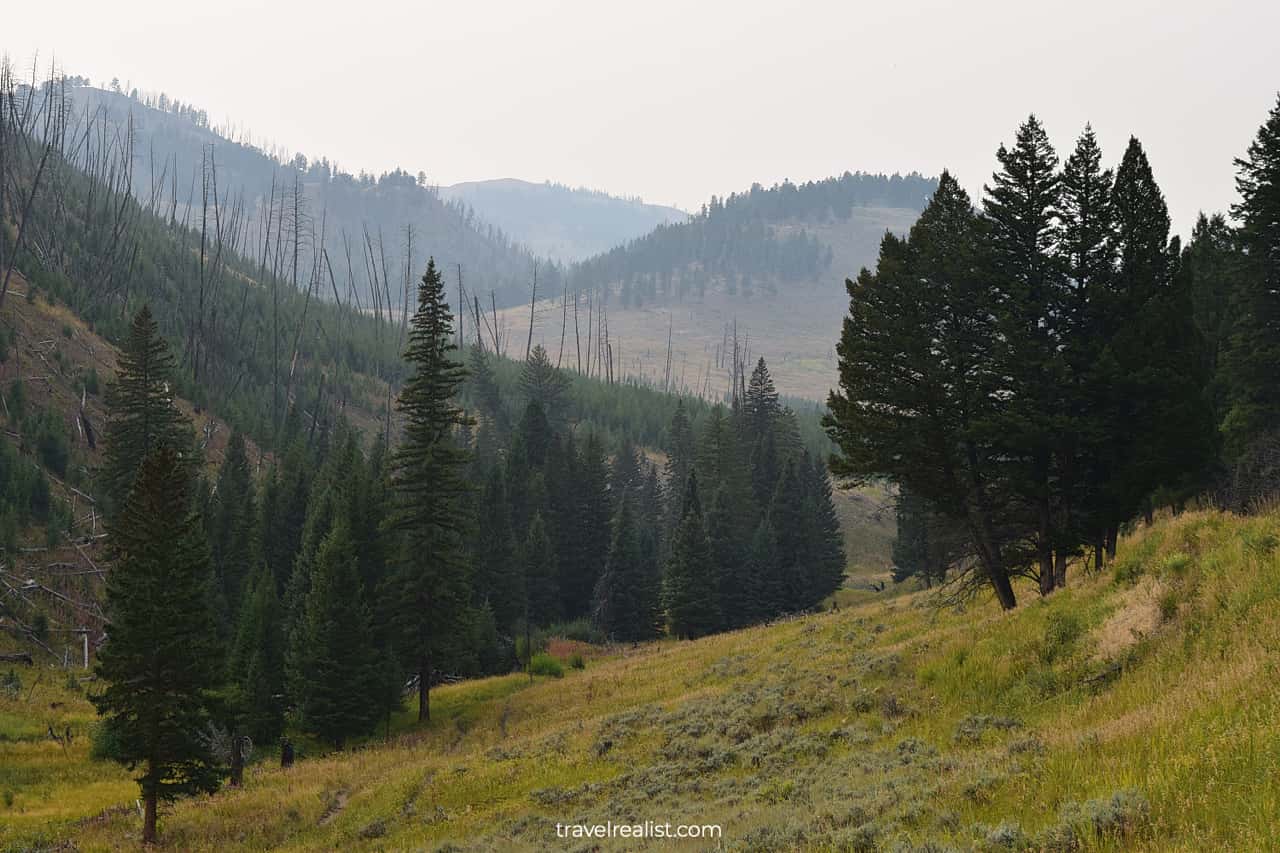
The Yellowstone petrified tree is still standing, which sets it apart from many fossilized stumps in Arizona. But the valley views give Yellowstone a true edge.
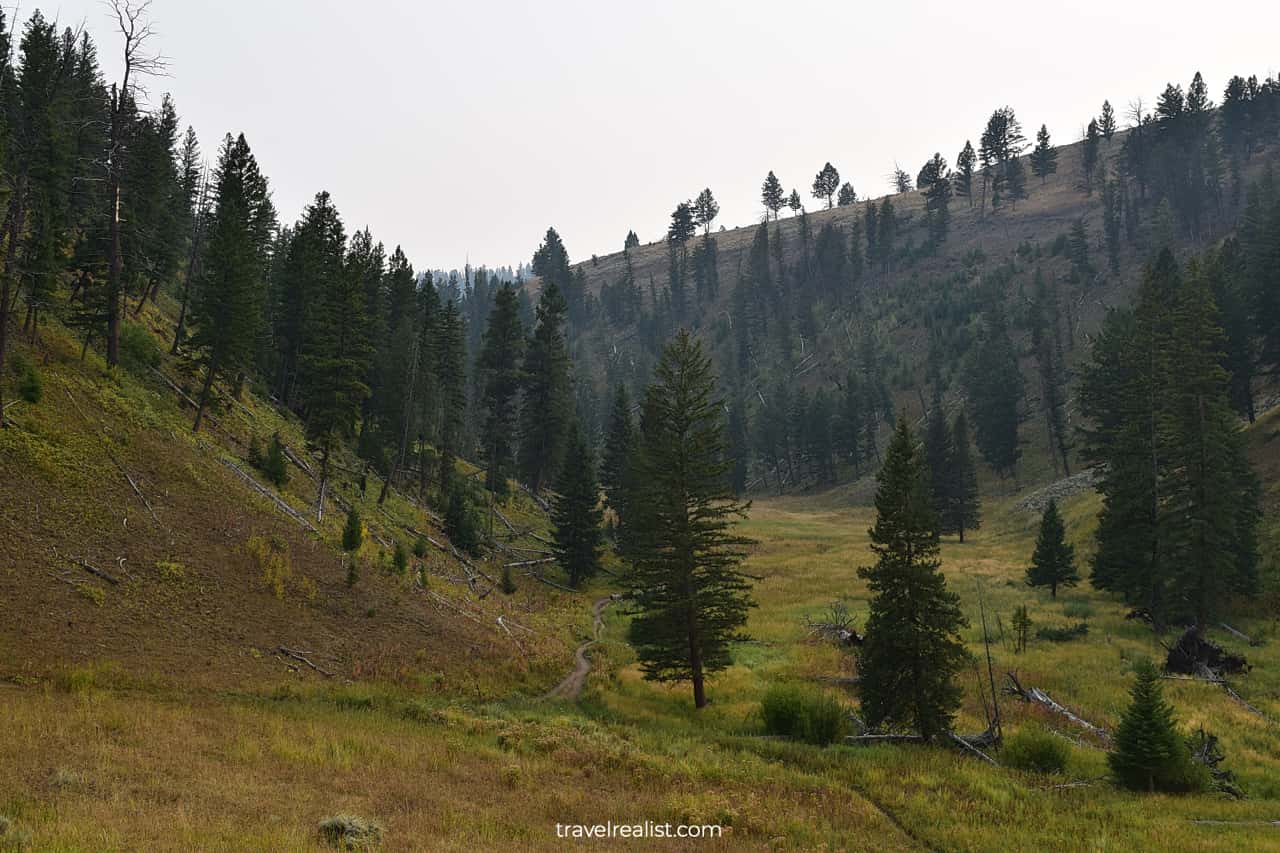
Buffalo Herds
The area following Tower Junction has few overlooks. But it is one of the best places in the park to see buffalo herds.
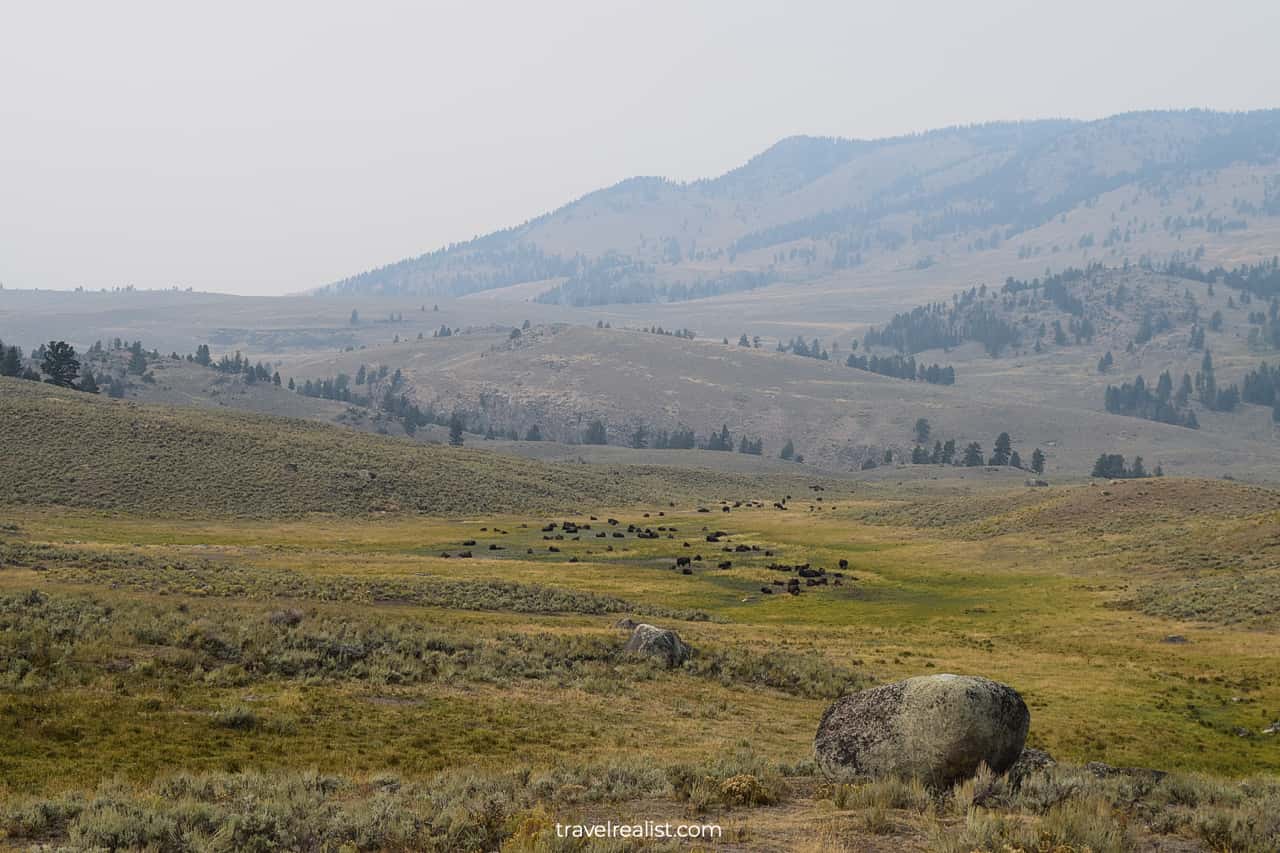
Most of the time buffalos would be fairly far from the road. But with some luck you could see a buffalo up-close. This experience resembles Theodore Roosevelt National Park. It was a great end to our Yellowstone journey.
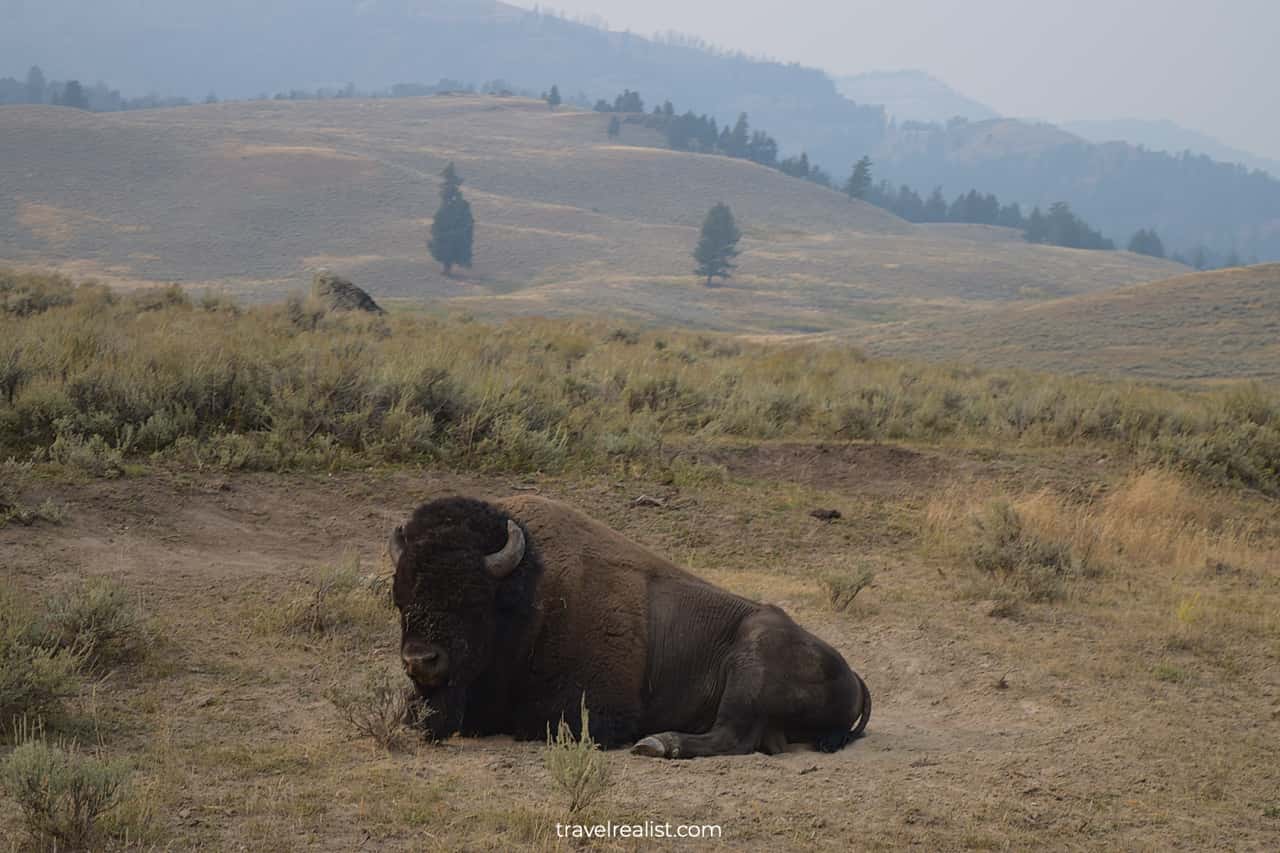
Continue with our Yellowstone Guide to learn more about ways to get to the sights, entrance requirements, and places to stay.
Getting to Yellowstone
Yellowstone National Park spans across three different states, Wyoming, Idaho, and Montana. It takes about a day to just get to the park. Moreover, the park is enormous. It is easy to take several days to explore all of its natural wonders. You can choose from three loop routes:
- Lower Loop: 96 mi (155 km) covers Old Faithful and most Geyser Basins.
- Upper Loop: 70 mi (113 km) covers Mammoth Hot Springs Terraces and several waterfalls.
- Grand Loop: 142 mi (229 km) covers both routes except for a 12 mi (19 km) stretch between Norris and Canyon Village.
Our Yellowstone Guide described about 75% of the Grand Loop route and its most scenic parts. The route from Tower Junction, WY to West Thumb, WY remains outside of the scope of this Yellowstone Guide.
Where to Stay
Yellowstone is one of the most visited national parks in the country. It creates some difficulties for visitors. Both parking and places to stay are limited. Most places to stay are in West Yellowstone, ID, Gardiner, MT, Cody, WY, and Jackson, WY. The latter two cities are a few hours away from the park’s sites.
Most places to stay charge a premium for proximity to Yellowstone. A successful visit to Yellowstone depends on advance planning. The sooner you book a place to stay, the higher are the chance you would get a good deal. If possible, visit Yellowstone on weekdays away from major holidays.
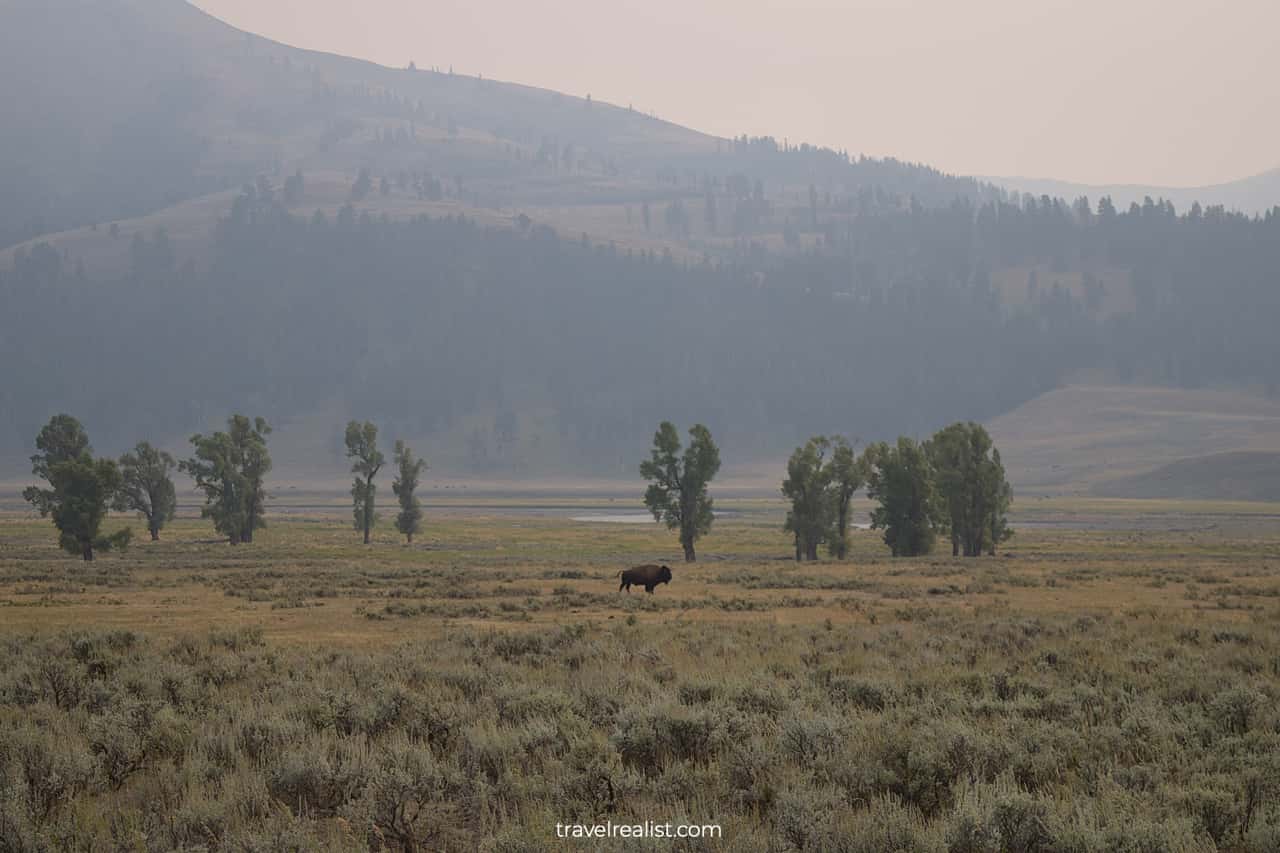
Entrance Requirements & Passes
Most roads in Yellowstone National Park are closed during winter. The only exception is the road connecting Gardiner, MT to Cooke City, MT.
Other roads to major sights reopen to public in late April and remain open till November. If you plan on visiting the park during the months of April and November, bookmark the Road Conditions page. We visited Yellowstone National Park during our summer trip to the Rocky Mountains region.
Yellowstone charges per-vehicle admission fees of $35. This is over 40% of the America the Beautiful Annual Pass price. If you pair a visit to Yellowstone with Grand Teton, the pass will almost pay for itself after one trip.
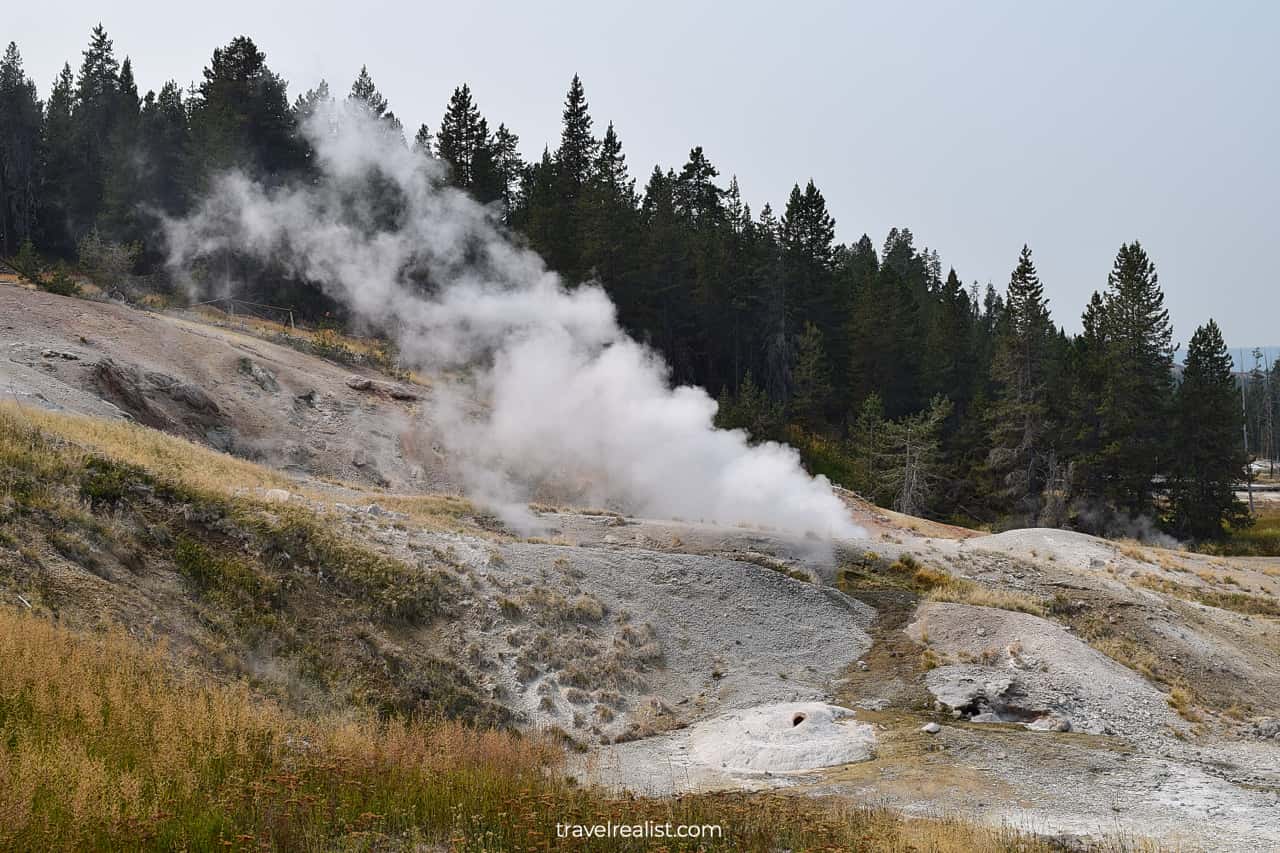
Takeaways: Yellowstone
Yellowstone National Park is an absolute national treasure. The Old Faithful, Mammoth Hot Springs, Black Sand Basin, Biscuit Basin, Grand Prismatic Spring, Sapphire Pool, Firehole Lake, and countless waterfalls make this park a must visit destination.
Take a look at our Yellowstone Video Guide and visit our YouTube channel for the latest videos.
Frequently Asked Questions
Yellowstone National Park has a lot of sights: from geysers, hot springs, and terraces to lakes, waterfalls, and wildlife.
May and October are the best times to visit Yellowstone National Park. The park roads will be open. And you can experience the park without summer crowds.
You need at least two days to explore Yellowstone’s major highlights.
While both national parks are scenic, Yellowstone has a greater variety of sights than Grand Teton National Park.
John D. Rockefeller, Jr., Memorial Parkway covers 7 miles between Yellowstone and Grand Teton National Parks. Major sights in both parks are further apart.
Flights, accommodation, and car rentals in Yellowstone are cheapest during late fall and late winter. But most park roads are closed during this time. The shoulder season just after the roads reopen offers the best value.
Jackson, WY is 57 miles from Yellowstone National Park’s South Entrance.
Staying in Yellowstone provides more time for exploration but at a premium. Places to stay outside the park are cheaper but involve a drive.
Yellowstone National Park does not require advance timed reservations.
Safe realist travels!


